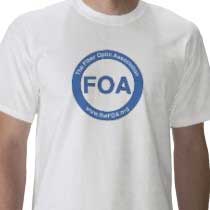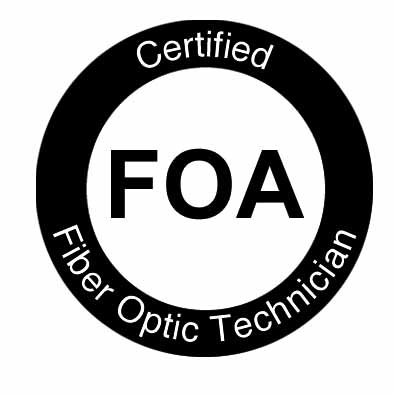The
classrooms have new interactive projectors that have inputs from
PCs and finger-touch recognition that allows writing on the
board with your finger - none of those messy markers required.
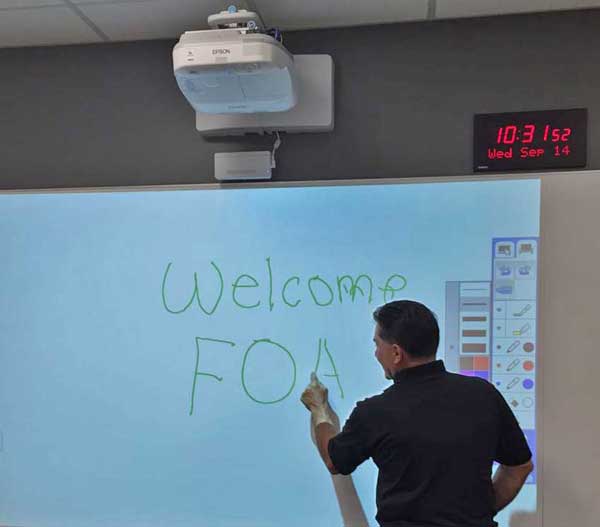
NorCal
has a small studio that allows making their own videos for
training.
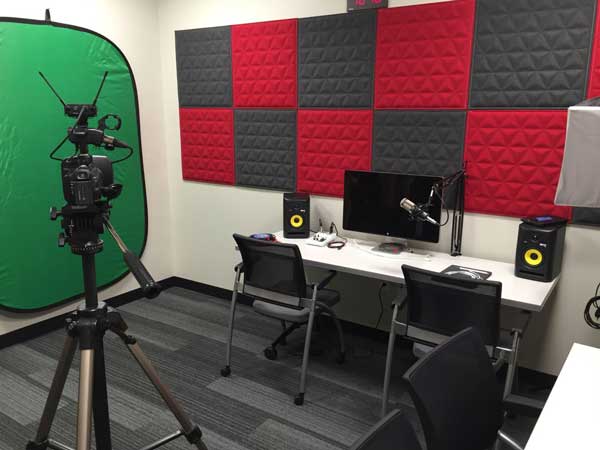
But they don't abandon older methods. Basil shows us drawings
used to train apprentices on reading and interpreting standard
paper drawings used on projects.
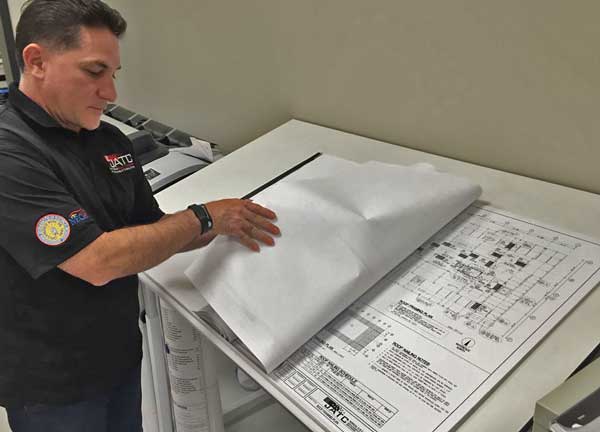
The most impressive part of the tour of this JATC facility is
the "Data Center."
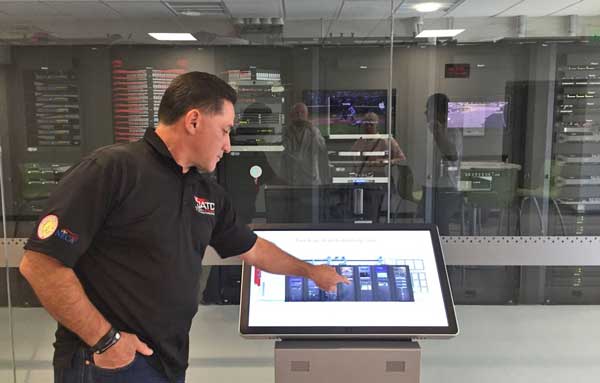
Rather than hiding all their LAN, video and phone hardware, they
built it in a glassed-in room in their break/lunch room for
everyone to see. They have another touchscreen panel with a
digital version of the data center that allows virtual tours of
the equipment so visitors and students can see how all the
equipment fits into the high tech learning environment.
We won't show you the more conventional stuff - classrooms and
labs with equipment for training apprentices on voice, data and
video cabling and equipment - but it's equally impressive.
The San
Leandro JATC is, of course, located in Silicon Valley where
keeping up with technology is a full time job. The facility
provides a learning environment that allows students to see
what is being done in tech and takes them "backstage" to
learn how this technology is connected using fiber and
copper cabling and wireless.
FOA has been a training partner with the JATCs from our
beginning. Today 30
JATCs in the US use FOA programs to certify students
and the FOA has been training JATC instructors at their
annual summer National Training Institute for 20 years. They
even print their own version of the FOA textbook. We often
point out to people who call FOA asking about careers in
fiber optics that the JATCs offer an apprenticeship program
that allows you to learn the technology of voice, data and
video cabling while getting paid to work in the field.
We've visited many of the JATCs over the years and they all
have impressive training facilities, but the San
Leandro JATC is the most high tech, at least today!
Wideband
Multimode Fiber (WBMMF) Has A New Name - OM5
We
have discussed wideband multimode fiber in the FOA
newsletter several times in the last two years, This is a
modified OM4 fiber that has been modified to allow
wavelength division multiplexing with VCSELs in the range of
850 to 950nm. Recently the ISO/IEC standards committees
agreed to call it OM5 fiber. Next up is the discussion of
whether it gets a special color instead of using aqua like
OM3 and OM4 fiber. The current proposal is to use "lime
green" - that should make it stand out in cable trays!
Kentucky
Wired Moving Forward In Eastern KY
The Kentucky
Wired broadband network is moving forward in eastern KY with
two new partners announced recently. The Kentucky
Communications Network Authority (KCNA), the entity overseeing
KentuckyWired, entered into strategic agreements with
Cincinnati Bell Telephone System (CBTS) and most recently with
East Kentucky Network LLC (EKN) to partner on broadband
network construction in north/central and eastern Kentucky.
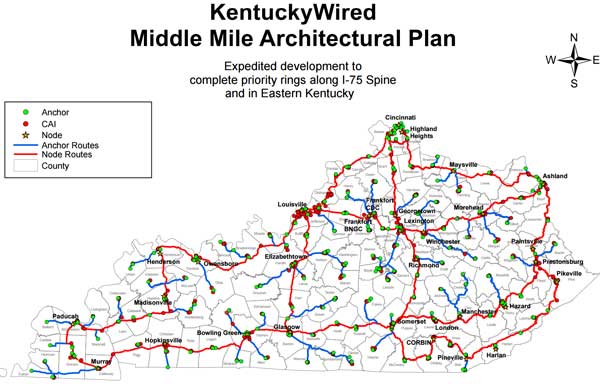
The EKN partnership covers 21 counties in eastern Kentucky and
will tie into the main trunk line from northern Kentucky. The
Cincinnati Bell partnership is critical in that Cincinnati is
one of two key gateways—along with Louisville—to the worldwide
web points of presence. A presence in both Cincinnati and in
Louisville provides redundancy in case one site has issues.
Without these links, KentuckyWired would just be a network
within the state with no connections to the high-speed, high-
capacity Internet.
“Cincinnati Bell is pleased to partner with the State of
Kentucky on this important initiative,” said Gary Peddicord,
General Manager, Carrier Services, for Cincinnati Bell.
“Cincinnati Bell has a long history of supporting economic
development efforts in the communities we serve, and broadband
connectivity is a key part of creating jobs and opportunity in
Kentucky.”
“EKN partner companies have been in business more than 60
years,” said Allen Gillum, CEO and General Manager of EKN. “We
are happy to be a part of KentuckyWired and to bring our
experience and resources to this important project.”
These agreements highlight KCNA’s ongoing commitment to work
with existing infrastructure companies to efficiently and
economically improve broadband services in the Commonwealth.
Additional strategic partnership discussions are currently
underway throughout the Commonwealth.
The KentuckyWired middle-mile network, a
public-private-partnership with the Macquarie Group, will
consist of more than 3,000 miles of fiber optic cable and more
than 1,000 government and post- secondary education sites that
will be connectivity points in communities for local internet
service providers to tap into for last-mile service to
customers. Preparation work has already taken place at nearly
100 government, university and community college sites in
eastern and northern Kentucky.
“The KentuckyWired project levels the mountains and the
playing field for the people of eastern Kentucky to compete in
the global, data-driven economy,” said Dr. Devin Stephenson,
president of Big Sandy Community and Technical College. “This
is the single most important investment in economic and
workforce development that will have a profound impact on the
entire Commonwealth, from Pikeville to Paducah.”
FOA is a training partner with KY Wired project through the
Kentucky Community And Technical College system. Big Sandy is
one of the 5 schools in eastern KY already offering FOA
training and certification in support of the project. More
schools will be coming online as the project expands.
Read
the KY Wired press release here.
Pennsylvania
Turnpike Plans To Install 550 Miles Of Fiber

The
Pennsylvania Turnpike Commission plans to develop a fiber-optic
cable broadband internet network along the 550 miles of
turnpike.The network would replace the turnpike’s
microwave-radio system, whose capacity to carry data from toll
plazas, camera systems and road sensors to centralized computers
will eventually reach its limit, turnpike officials said.
Turnpike chief information officer Scott Fairholm envisions a
system that transmits traffic, road and weather conditions
directly into car and truck dashboards outfitted to accept the
information, a feature future vehicles will certainly have.
Consultants will help choose private contractors to build the
system at their own expense, operate it and sell excess network
capacity to other state agencies or private businesses. The
public-private partnership means construction and operations
won’t cost the turnpike anything and could produce some revenue
from selling excess capacity
Scranton
Times-Tribune October 17, 2016
Where
Are FTTH Networks In America?
A good
place to find out is the "National
Broadband Map" maintained by NTIA,
the US National Telecommunications And Information
Administration. The map below shows the FTTH map, but you
can also see maps for DSL, cable modems and wireless. You can
also read
broadband news here.
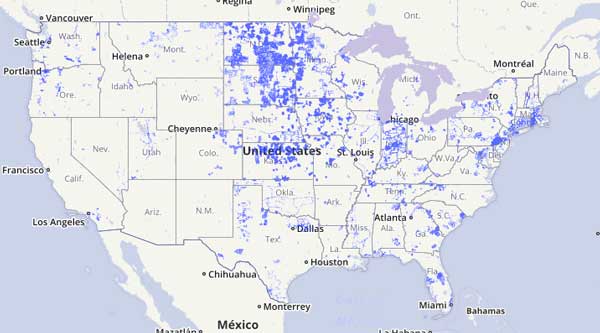
178
Communities In America Are Building Broadband Networks
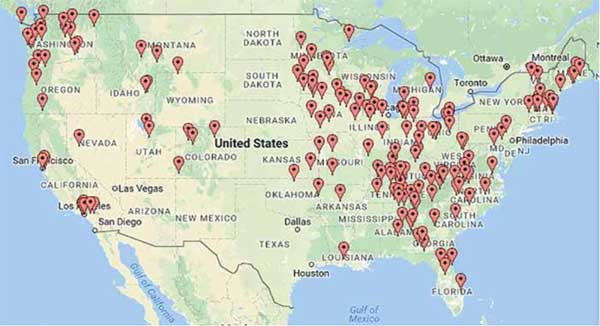
Broadband
Communities Magazine has counted 178
Communities in 38 US States And American Samoa that are at
some stage in developing or operating municipal owned
broadband networks. This article is a very good read if you
are interested in developing a muni broadband network
because it shows the numerous ways these operations can be
structured. Some are public owned, many by electrical
companies, some public/private partnerships and some started
public but have been sold to private operators. Some only
offer services to businesses, others to consumers. Some are
their own ISP, others offer a distribution network for ISPs.
The article includes a table of all the systems and the way
they are structured.
Mandatory reading if you are considering such a move.
Read
more in Broadband Communities Magazine
How Do
You Identify A Counterfeit Cleaver"
FOA Master
Instructor Bill Graham sent us this photo of two cleavers , one
a real Sumitomo and one counterfeit. Can you tell the
difference?
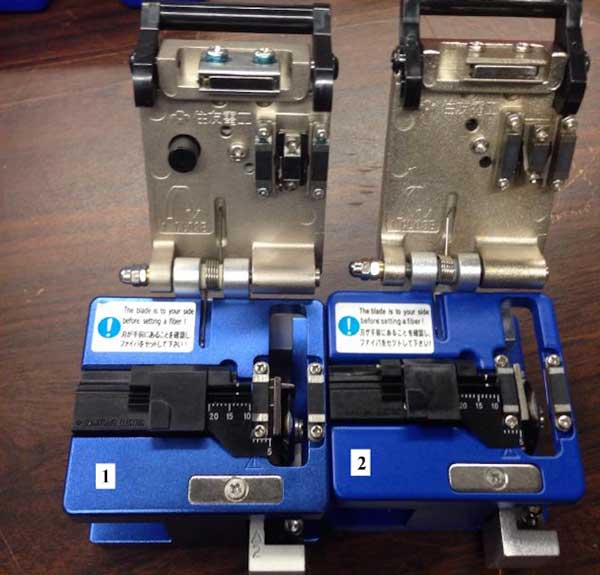
#1 is the real Sumitomo cleaver which sells for about $800 and
#2 is a counterfeit that sells for about $85.
The first thing to note is the poor quality of finish of the
metal and the roughness of the cast in logo on the top. It's
also missing the hold-down (round black plastic piece.)
In use the operation is not as smooth, especially the cutter
blade sliding to scribe the fiber.
The cleaves are not as good or consistent, not adequate for
critical work.
As they say, you get what you pay for.
Is This
A Better Idea For MPO Connectors?
As you can
see below (next article) MPO connectors have a large area that
can get dirty. They also depend on the polishing process leaving
fibers protruding from the ferrule surface to ensure physical
contact for low loss and reflectance. A typical MM MPO looks
like this on an interferometer:
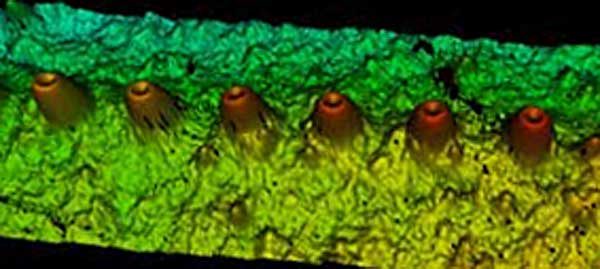
Polishing
the connector so that all fibers protrude equally is not easy,
but is mandatory to get consistent loss on all the fibers. You
might remember an article in this newsletter that quoted a study
about the MPO claiming that the outer fibers had higher
loss. That article prompted feedback from a cable manufacturer
who said it appeared to be an artifact of the polishing process
and that another brand of polishing machine gave results where
the inner fibers had higher loss. Puzzling!
Another option is the termination process developed by Arrayed
Fiberoptics Corp. that polishes the MPO ferrule so that
the fibers are undercut slightly, then the ferrule is coated
with an anti-reflection coating like the coatings used on
photographic lenses. The Arrayed MPO looks like this:
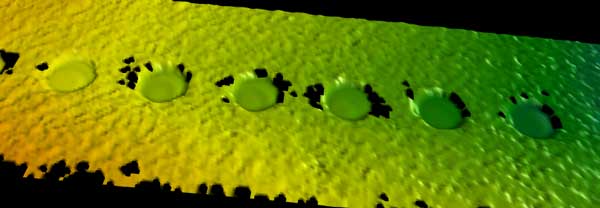
You can see the fibers do not protrude but are just slightly
below the surface of the ferrule (just microns below). Generally
this would cause high reflectance (~ -20dB) if there were an air
gap between the fibers, but the ferrule ends are coated as you
can see in this photo:
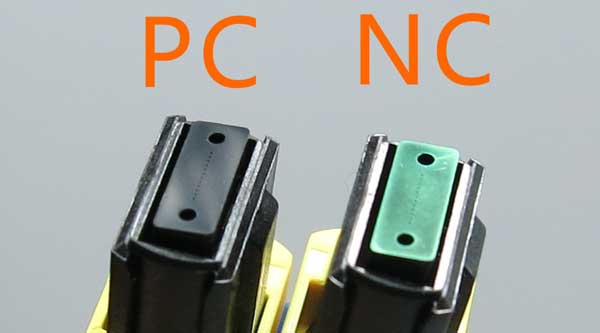
The ferrule on the right has an antireflection (AR) coating that
reduces loss even with non-contact fibers. The manufacturer
claims that this provides more repeatable loss on the line of
fibers and reduces potential damage to the fibers. Although not
one of their claims, AR coatings are often harder than glass and
certainly the glass-filled plastic ferrule, so this should be a
much more durable MPO.
For more information, go to Arrayed
Fiberoptics Corp.
Why You
Should Inspect ALL Fiber Optic Connectors And Clean ALL of
Them
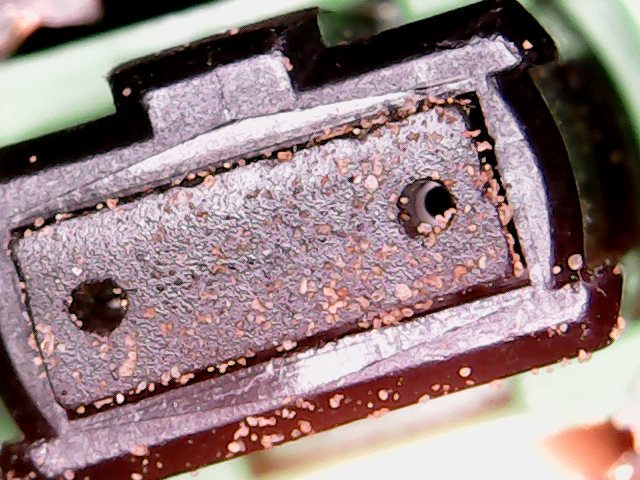
"Contamination
on the end face is 'job-1". However, while this is a
dramatic image, there can be contamination on other aspects of
the connector. My point in all of this is that cleaning
the end face is critical...but also understanding there are
potential "soil points" from other areas can/will/may save lots
of frustration. "What if dust in an alignment port
is causing misalignment of fibers
2-6-8?" Right now we are teaching to
clean the most important sectors...and that must not stop...but
teaching awareness of other aspects is the essence of "Best
Practice...to Future Proof"." Image and comment from Ed Forrest.
http://www.fiberopticprecisioncleaning.com/
Need A
Secure Network But Want Data From It - Make It "One Way"
Recently an
IT person called FOA with a question. They wanted to be able to
transfer information from a remote site to a corporate network
but did not want to risk the site being compromised if the
corporate network was hacked. The solution was to make the fiber
link one way - only allowing transmission from the remote site
to the corporate network. This is not as easy as it sounds since
most fiber links are designed to be full duplex and many will
stop transmitting if there is no return signal. Plus, there
needs to be additional safeguards against data corruption.
It turns out the US Government has worked out the details and
conveniently patented it so we can find our how they did it. It's
Patent US7260833 and you can read the entire patent
application here.
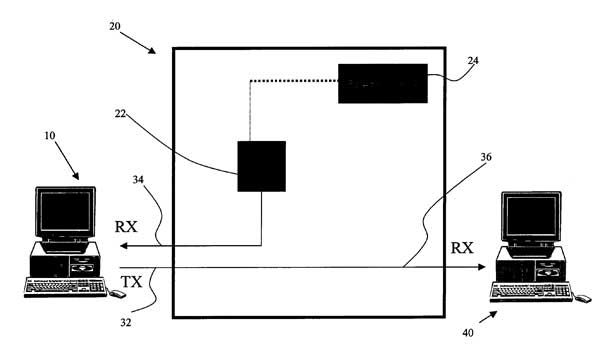
This implementation uses hardware to simulate the return link
but a media converter company should be easily able to make a
one way link. Anybody know if such a thing exists?
Good
Practice Tools For OTDRs, All Free
FOA
OTDR Simulator
You
may already know that the FOA has a free OTDR Simulator you can
download from our website (go
here for directions) that allows you to practice using an
OTDR on your PC, seeing the effects of changing setup parameters
and analyzing dozens of real world traces. But here are two more
tools that can be good for practice.
OTDR
FAQs
Including
more hints from FOA Master Instructor Terry O'Malley like tests
on what the end of a fiber trace looks like with broken and
cleaved fibers.
Frequently
Asked Questions On OTDRS And Hints On Their Use
"Fiberizer"
APP Reads, Analyzes OTDR Traces
Fiberizer
is a iPhone/iPad APP that reads industry-standard ".sor" format
files and allows trace analysis on your iPhone or iPad. An
android version is in the works too. Read
more about Fiberizer. And
here are more directions on its use.
You
Should Worry About Static Electricity When Cleaning Connectors
We all know the problems with dirty connectors but keeping
connectors clean, even after just cleaning them, can be a
problem. The Microcare Sticklers people have been talking about
the problem of static electricity for some time. When you clean
a connector with a dry cleaner, you may cause a static charge on
the connector ferrule that will attract more dirt from the air.
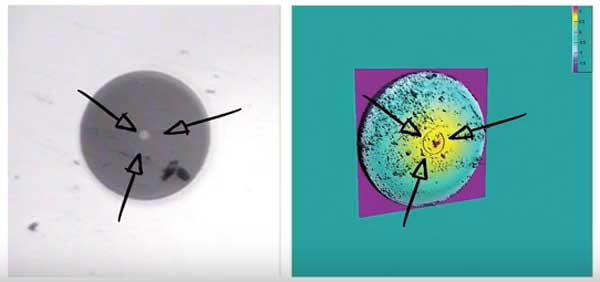
Sticklers solution is a cleaning fluid that is conductive and
prevents static. Used with their cleaning tools, it reduces the
static problem and helps ensure clean connectors. Watch
their video here.
The
Microcare Sticklers people tell us they working on a series of
five training videos about how to clean various connectors by
application and should have the videos done by the end of
September. We'll update you on those next month.
Useful
Online Resources
We often
have contacts give us online links for useful information which
we like to share with our readers. Here are two:
Electrical/Low Voltage Workers
in Wisconsin
Casey Healey, Business Agent for IBEW Local 159 in McFarland,WI
suggested a link to the Wisconsin
Electrical Workers on the FOA jobs website. They have nine
IBEW locals that cover the entire state of Wisconsin. All nine
locals use this website in search of low voltage technicians
that are certified in copper or fiber. After an individual fills
out the employment opportunities form on the website a
representative from that person's area would be in contact with
them to discuss job opportunities within the IBEW as a low
voltage apprentice, trainee or a technician. In Wisconsin they
teach the 3 year NJATC Voice Data Video apprenticeship program.
WI JATCs use the books that FOA has written for the NJATC in
their curriculum.
Finding Legal Information
As
the two articles above illustrate, sometimes you get involved in
a situation where you need local legal information or
assistance. When you need legal information around the US, it
can be very frustrating to find the right contacts. A friend of
the FOA, Debbie Mayer, sent us this lead:
"I came across a site that has alleviated my frustrations and
has proven to be rather accurate for my own purposes. The site,
courtsystem.org
seems to have a complete database of listings for all emergency,
legal and law enforcement government offices in the country –
with working phone numbers (at least for the ones I’ve tried!).
I wanted to share the site because it has saved me a few
headaches and I’m sure it would be useful to others as well."

The word on
the "Dig Once" program is getting out - FOA is getting calls
from cities asking us for information and advice. It helps that
the current Administration is trying to convince cities of the
advantages of installing ducts or conduits when they dig up a
street so they don't have to do it again. Here are some links
for more information.
The DoT page on the administration’s Executive Order: http://www.fhwa.dot.gov/policy/otps/exeorder.cfm
From the Council of State governments: http://www.csg.org/pubs/capitolideas/enews/cs41_1.aspx
From the city of San Francisco: http://sfgov.org/dt/dig-once
An article about Dakota County, MN: https://muninetworks.org/tags/tags/dig-once
And
the one to download and hand out:
A “How To” Guide from The Global Connect Initiative: https://share.america.gov/wp-content/uploads/2016/04/6.-GCI-Dig-Once.pdf
Lennie
and Uncle
Ted's Guides Are Updated And On The FOA Website
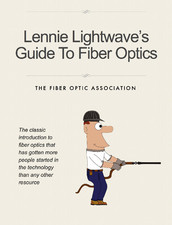
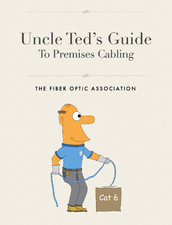
Lennie
and Uncle
Ted's Guides have moved to the FOA website.
Lennie is the place where many if not most fiber techs
begin their education. FOA has just updated the two guides
to ensure they stay relevant - more than 20 years after
they were first written.
Lennie goes all the way back to 1993 when he was created
as the mascot of the original "Fiber U" conference - the
same Fiber U that is now the FOA's web-based training
site. Lennie
Lightwave's Guide To Fiber Optics was created as
a beginner's introduction to fiber optics. Over 60,000
printed version of Lennie's Guide were given away and it
became one of the first commercial web pages in 1994. Uncle
Ted's Guide To Communications Cabling was written
a few years later to introduce techs to "Cat 5" - UTP
wiring - that had only recently been standardized in
TIA-568.
Lennie and Ted's Guides are used in the current Fiber U
online self-study programs and are still the best place to
start learning about fiber optics.
Lennie
and Uncle
Ted's Guides are online at the links here, can be
downloaded as printable PDFs and are now also available as
free iBooks on iTunes.
Articles
Worth Reading On 
FOA has
been posting articles "Worth Reading" on our Pinterest
board instead of including them in our monthly newsletter.
If you subscribe to our board, you get notified when the
articles are posted instead of waiting until the end of the
month. Recently postings include:
Sign up at the FOA Pinterest
"Worth Reading" board
Two New
Books From FOA - Not Just For Installers - Their Bosses Need
To Read Them Too!
These
books should be on the bookshelves of network
owners or managers, facilities managers, supervisors of
the installers and anyone else involved with fiber optic
networks.
FOA has
published two new books that provide useful information for
those involved in fiber optic projects, and not just for
installers. The latest, the FOA
Reference Guide To Fiber Optic Network Design,
is a comprehensive guide to designing fiber optic networks of
any type, from concept to completion. This book looks at design
from the initial need for communications through the process of
setting the route of the cable plant, choosing components,
finding a contractor, planning the installation and documenting
the process from beginning to end.
While one might think the focus of the design book is on the
person actually designing the network, it is also aimed at those
for whom the network is being designed - the network owner or
manager, facilities manager, supervisors of the installers and
anyone else involved in the process. We especially think that
everyone who contracts for fiber optic installations should have
a copy of this book on their bookshelf as a reference for when
they are involved in a project.
The second book which we released recently, the Outside
Plant Construction Guide, is another book aimed at a
wider audience than installers. Certainly it's of interest to
installers, being the only book we know about the actual
construction process of installing fiber optic cables, but it is
also useful to the designer of the network and those who
contract for fiber optic cable plant installation, especially if
they are involved in getting permits and easements or having to
explain to others the process of installation.
Both books, like all
FOA books, are inexpensive and available in paperback or
Kindle formats.
FOA
Reference Guide To Fiber Optic Network Design And FOA's
Outside Plant Fiber Optic Construction Guide
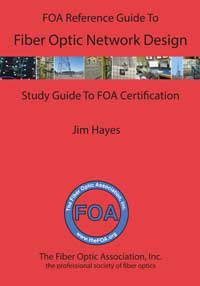
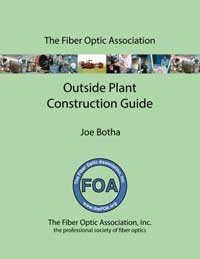
Read
More about the FOA
Reference Guide To Fiber Optic Network Design
and
More
information on the FOA
Outside Plant Fiber Optics Construction Guide
Want To
Learn More About DIY FTTH?
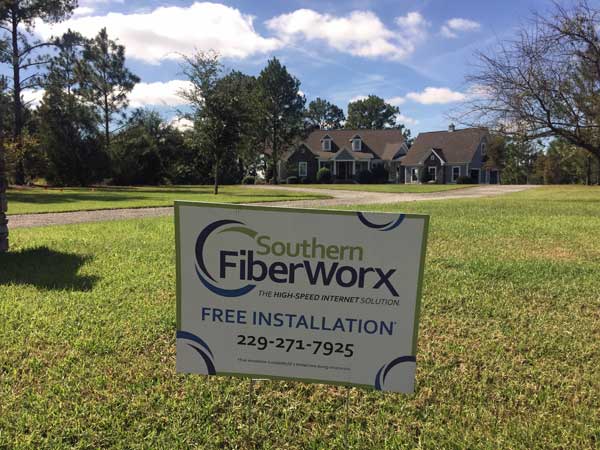 Southern
Fiberworx is a DIY FTTH Project in Georgia
Southern
Fiberworx is a DIY FTTH Project in Georgia
It seems
like every week FOA gets another call from a town, real estate
developer or utility wanting to start a FTTH project for their
area. FOA has created several videos and a a web page on this
topic to help anyone get started.
FTTH
Case Studies: Do-It-Yourself FTTH
FOA has a
series of videos on do it yourself (DIY) FTTH. The first three
videos are online now:
FOA
Lecture 45 Do It Yourself FTTH (Fiber to the Home) What's
involved in building a FTTH network of your own.
FOA
Lecture 46 Do It Yourself FTTH (Southern Fiberworx)
(FOA Newsletter
November 2015) How one company, Southern Fiberworx in
Cordele, GA did it themselves.
FOA
Lecture 46 Do It Yourself FTTH (Southern Fiberworx)
(FOA Newsletter
November 2015)
Another
Source Of Articles On Fiber
FOA
President and editor of this newsletter Jim Hayes has also been
writing a column in Electrical
Contractor Magazine for more than 15 years now. Electrical
contractors do lots of fiber work and this column has covered
some toics they are interested in including installation
processes, network design, fiber applications and in the last
year, a lengthy series on dark fiber - what it is, how's its
used and how it benefits the growth of communication. A recent
web site redesign makes it easier to browse all these articles -
just go to http://www.ecmag.com/contributing-authors/jim-hayes
and you can see all of them.
Keep Up
With Google Fiber News
Google is
moving ahead in Austin and starting in the SE building Google
Fiber networks. They just announced projects in San Diego and
Irvine, CA and Louisville, KY. Here is where to keep track
of what is happening with Google Fiber - the
Google Fiber Facebook page!
Fiber
Optic Education For Students At Any Age
We hear
about fiber optics all the time - it's in the news whenever we
hear articles about high tech, the Internet and communications,
and many communities are getting "fiber to the home." But few
people really understand fiber optics or how it works. FOA is
focused on educating the workforce that installs and operates
these fiber optic networks but we're always getting inquiries
from STEM (science, technology, engineering and math) teachers
who want to introduce fiber optics to younger students in K-12
grades or technical schools.
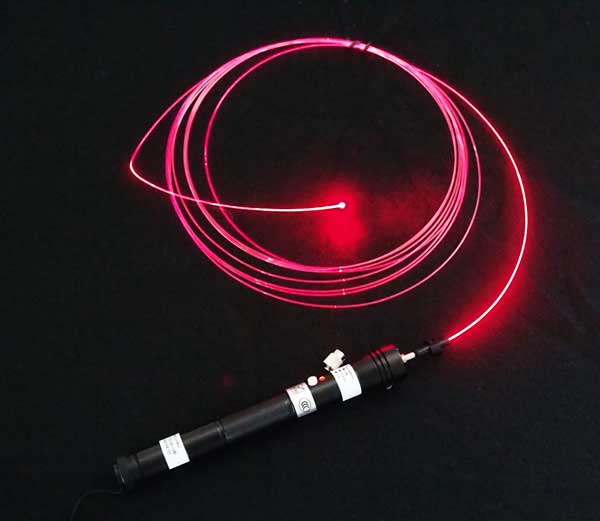
Using red laser light (a VFL here but a laser pointer works
also) to show how fiber guides light.
FOA has begun developing a series of YouTube videos intended for
teaching students in elementary, middle and high schools about
fiber optics. The first FOA video is titled "Fiber
Optics For Teachers." With this video, we show teachers
how fiber works and carries signals and then explains simple
experiments to demonstrate how fiber optics works in the
classroom using some plastic fiber and a laser pointer. Since
many teachers do not know where to get the fiber, the FOA offers
to send them a sample for use in demonstrations in their
classroom (USA only right now.)
At the end of the video, teachers are given directions on how to
request samples of the plastic fiber from the FOA.
This video joins the "Fiber Optics Live" series How
Light Travels In A Fiber, Fiber
Attenuation and Connector
Loss that show how fiber works using simple experiments
that can be duplicated in any classroom. More videos will be
coming soon.
If you have kids or know some teachers who would be interested,
please send them to the introductory video Fiber
Optics For Teachers and we'll be glad to help them
get started with some entertaining programs for their
classrooms.
Resources
For Teachers In K-12 And Technical Schools
Teachers in all grades can introduce their students to fiber
optic technology with some simple demonstrations. FOA has
created a page for STEM or STEAM (science, technology,
engineering, arts
and math) teachers with materials appropriate to their
classes. Fiber Optic
Resources For Teachers.
If
you have kids in school or know teachers who are interested,
send them to the FOA page Fiber
Optic Resources For Teachers.
Ruby
Opto Systems (India) Offers Educational Systems For Fiber
Optic Fundamentals
The present
technological advancements in STEM (science, technology,
engineering and math) education have evolved through research on
basic experimentations. Optical fibers applications are no
exceptions.
RUBY OPTO SYSTEMS in India has developed a series of educational
apparatus to help demonstrate fiber technology and help students
understand the theoretical and experimental aspects of optical
fiber technology and optical fiber sensor applications.
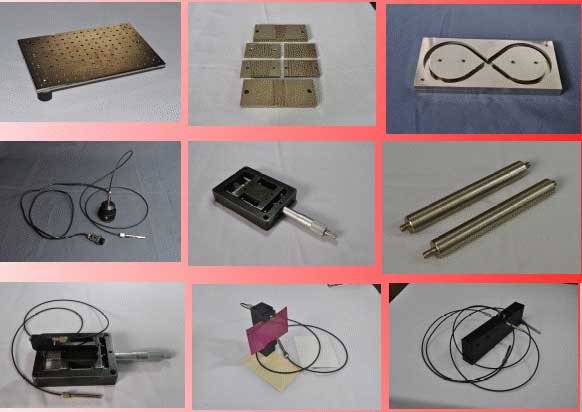
The design of experiments comprises of losses or attenuation due
to bending (total internal reflection),
misalignments (through beam) and sensing (reflective beam)
apart from losses due to optical fiber end preparation, optical
fiber lengths, source and detector coupling and the numerical
aperture of an optical fiber.
The optomechanical components are ergonomically designed
for the purpose of hands-on experience. The methodical procedure
of conducting the sequence of experiments substantiate towards
the understanding of basic principles and further basic
computation of power budgeting, the fundamental criteria of an
optical fiber network. The seamless integration of modules/
components based on the design of the experiment make s it
versatile and not a mere plug and play monotonous activity.
For more information, see the Ruby-Opto
website or email the developer, Parimal Kowtal at
<parimal.kowtal @ gmail.com>
Should
Your Company Become An FOA Corporate Member?
As all FOA
individual
members know, they join the FOA by becoming certified,
mostly taking their CFOTs but some CPCTs, either by
attending a FOA approved school or joining directly based on
field experience (our "work to cert" program.) Over the years,
we've been contacted by manufacturers, contractors, consultants,
and other types of organizations who ask about becoming members.
We don't certify companies or organizations, we told them, so we
were not sure what we could offer as a benefit of membership.
But then, companies asked about using our educational programs
to train employees, how they could get listed on the FOA website
as service providers or if they could get a quantity discount on
membership or certification for all the FOA members working for
them. That began to sound like a benefit for being an FOA
corporate member. And providing a list of useful suppliers to
the market could be a benefit to the industry as a whole.
So FOA has quietly been letting companies and other
organizations join the FOA to take advantage of those benefits
so we now have several hundred corporate members. We've put then
into a database and listed them on the FOA website in map
and list
form. Here's the map.
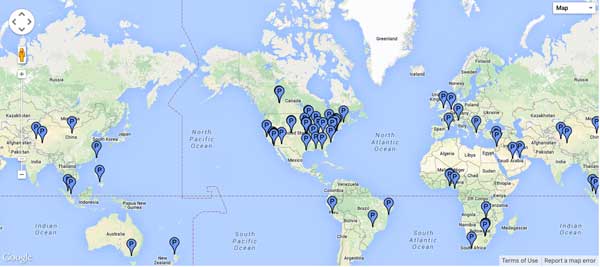
The online map
and list
can be used to find suppliers and service providers.
The map, like our map of schools, lets you find the FOA
corporate members close to you. The table form lists them
by category: Installer/Contractor, Component Manufacturer,
Installation Equip. Manufacturer, Transmission Equipment,
Services/Consulting, Distribution and Users of Fiber Optic
Networks. You can sort the tables to find members meeting your
needs, e.g. by location, certifications offered, etc. Click on
any column heading to sort that column; click twice to sort in
reverse order.
How
Does An Organization Become An FOA Corporate Member?
Simple,
just fill in the online
application form. When your application is accepted, you
will be asked to pay the membership fee - $100US first
year, $50US/year or $100US/3years to renew. You will then be
listed on the online
map
and list,
have access to exclusive FOA educational materials for your
employees and get discounts on certifications and
renewals.
EXFO
Offers Super Posters And More

EXFO offers some super posters, guides and books. The FTTx and
OTDR posters are really useful! Look
at the whole selection here
MPO
Connectors
There are numerous polarity options for MPO connectors and
adding the options for breakouts on each end, you can see how
it's easy to fill 23 pages of the TIA-568 standard with
diagrams. We've tried to simplify it on an expanded
MPO page on the FOA Guide which we recommend you read.
There is a new YouTube video on this part of the MPO polarity
also.

New
FOA YouTube Videos - Focus On MPO Connectors - Prefab Cabling
With MPOs, Testing MPOs and MPO Polarity
We continue
to get inquiries about MPO connectors, especially testing them.
A continual concern is the variability of loss when testing
them. It seems they are not all that repeatable, making testing
confusing. We've tried to create materials that explain them and
their use. We've
recently added three more videos - all focused on the MPO array
connector - to the FOA
YouTube channel.
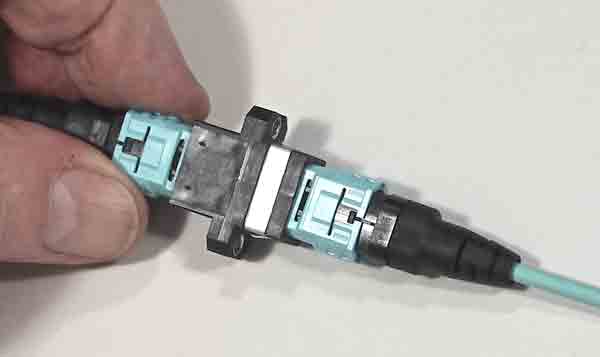
The Panduit PanMPO Connector
FOA
Lecture 41 Prefabricated (Preterminated) Fiber Optic Cabling
Systems
FOA
Lecture 42 MPO (Multifiber, Array) Connectors and How To
Test Them
FOA
Lecture 43 Managing Polarity of MPO Connectors (using the
PanMPO Connector)
FOA
Lecture 44 MPO Connector Fiber Polarity
Safety
On The Job


Safety is
the most important part of any job. Installers need to
understand the safety issues to be safe. An excellent guide to
analyzing job hazards is from OSHA, the US Occupational Safety
and Health Administration. Here
is a link to their guide for job hazard analysis.
FOA also has lots of information on safety: FOA
Guide, YouTube
video and a Safety
Poster
"Worth
Reading" Is Now On
Join
FOA on Pinterest.
We have been posting links to pages "Worth
Reading" on a special FOA Pinterest page. You can join and
keep up to date with the news on our industry which we put
there.
Recent
posts cover utilities using new generation telecom, India's
plan for 100 smart cities, Cincinnati Bell bets on fiber,
various opinions on the US battle over net neutrality, etc.
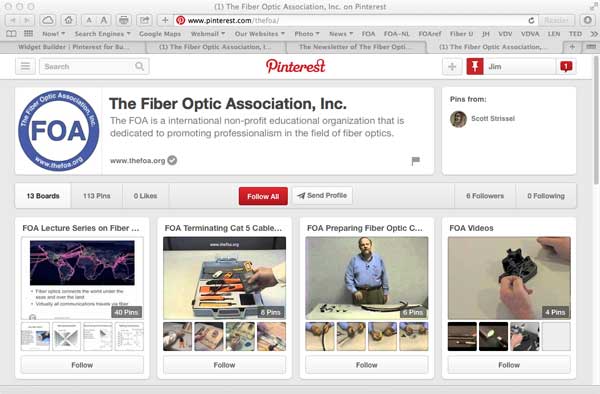
Good
Practice Tools For OTDRs, All Free
FOA
OTDR Simulator
You
may already know that the FOA has a free OTDR Simulator you can
download from our website (go
here for directions) that allows you to practice using an
OTDR on your PC, seeing the effects of changing setup parameters
and analyzing dozens of real world traces. But here are two more
tools that can be good for practice.
OTDR
FAQs
Including
more hints from FOA Master Instructor Terry O'Malley like tests
on what the end of a fiber trace looks like with broken and
cleaved fibers.
Frequently
Asked Questions On OTDRS And Hints On Their Use
"Fiberizer"
APP Reads, Analyzes OTDR Traces
Fiberizer
is a iPhone/iPad APP that reads industry-standard ".sor" format
files and allows trace analysis on your iPhone or iPad. An
android version is in the works too. Read
more about Fiberizer. And
here are more directions on its use.
Events of
Interest
Don't
Miss These Seminars and Webinars:

TIA
FOTC offers regular webinars and archives
them here so you can watch anytime.

Installation
and Management of Customer-Owned Outside Plant Cabling
by Hubbell and Clearfield
The
specification, design, installation and management of
customer-owned outside plant cabling systems require
knowledge, tools and systems that often differ from those used
for in-building communication systems. The physical conditions
are less benign, which affects everything from installation
techniques to the equipment that houses and protects the
cabling. This web seminar hosted by Cabling Installation &
Maintenance addresses several aspects of customer-owned
outside plant cabling administration, emphasizing the
capabilities and physical requirements of products and systems
deployed in these environments.
Watch
anytime - sign up here.
Fiber
Testing - Presented By Jim Hayes, FOA
This
webcast seminar, presented by Jim Hayes, examines several ways
in which fiber testing- both insertion loss and OTDR testing -
has evolved. The seminar will begin with a basic tutorial of
fiber-transmission principles and test fundamentals. It will
then discuss the uncertainties of each fiber-optic measurement
method. The seminar will then address some of the developments
that have served to improve the certainty of test results, as
well as how technicians can use their instruments more
effectively to reduce measurement errors.
Watch
Anytime - Sign Up Here
~~~~~~~~~~~~~~~~~~~
 New
local programs for fiber installation training New
local programs for fiber installation training
See
the Light® Fiber Optic Training Program
Webinars, seminars and certification training classes.
Corning offers a library of
more than 200 videos that help our customers with
everything from product preparation and installation to proper
testing procedures. Our free Video Library Tool provides direct
links to individual Corning videos, and allows you to filter by
topic or area of interest. Register
to download the Video Library Tool.
~~~~~~~~~~~~~~~~~~
RETURN
TO INDEX
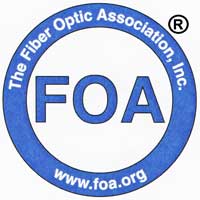 What's
Happening @ FOA What's
Happening @ FOA

FOA
has three LinkedIn Groups
FOA
- covers FOA, technology and jobs in the fiber optic marketplace
FOA
Fiber Optic Training - open to all, covers fiber optic
technology and training topics
Grupo
de La Asociación de Fibra Óptica FOA (Español)
FOA
Standards:
FOA now offers free standards for datalinks and testing the
installed fiber optic cable plant, patchcords and cable, optical
power from transmitters or at receivers and OTDR testing.
What
Is A Fiber Optic Cable Plant?
In a recent
standards meeting, that issue was discussed with some
disagreement as to what constituted a "cable plant." It seemed
to be a perfect topic for another FOA "1Page Standard," so a
draft version is now uploaded for review (FOA
Standard FOA-6, Fiber Optic Cable Plant). Feel free to
review it and comment to the FOA at info@thefoa.org.
Available
also is a new standard for Datalinks.
Look for the "1
PageStandard" web page and in the FOA Online Reference
Guide.
Go to the
FOA "1
Page Standards"
NECA/FOA
301 Fiber Optic Installation Standard
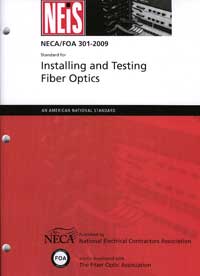
Standards
cover components and systems and how to test them, but rarely
get into installation issues. The FOA NECA 301 standard which
covers installation of optical fiber systems has been revised
for the second time, adding considerable new materials. This
standard is derived from FOA educational material put in
standards form and approved by ANSI as an American National
Standard. It's specifically written to be used in contracts to
define "installation in a neat and workmanlike manner." The
standard is available from NECA.
FOA members can go
here for instructions on how to download your free copy.
Application
of Standard Project Management Processes in Fiber Optic Cable
Plant Project Management
By
Alfred
Sankara, PMP, CFOS/D – Telecommunications Project Manager
Organizations in the communication industry are proving that
adopting proven project management practices reduces risks, cuts
costs, and improves success rates of projects. The present
article demonstrates how standard project management processes
apply to fiber optic cable plant project management.
The article compares the Project Management Institute (PMI)’s
standards and guidelines to the FOA’s best practices in terms of
fiber optic cable plant project management. PMI is the
world's leading not-for-profit professional association for the
project, program, and portfolio management profession. PMI
strives to mature the profession of project management through
standards, certifications, resources, tools, academic research,
publications, professional development courses, and networking
opportunities.
The PMI’s Guide to the Project Management Body of Knowledge
(PMBOK ® Guide) defines the project lifecycle as a combination
of the following three (3) main phases: Project Initiation,
Project Execution, and Project Closing. This article shows that
the FOA’s fiber optic cable plant project management lifecycle
phases, which include the Design, Installation, and Testing, fit
with PMI’s recommended project lifecycle.
Alfred
Sankara is a
telecommunications specialist who has been active in the
planning, deployment, and operations of telecommunications
infrastructure since 1999.In the United States and Africa,
Alfred has been involved in the execution of various
telecommunications projects, including plans and
specifications development, fiber optic network deployment
(FTTH, SONET, DWDM, Carrier Ethernet, and OTN) and wireless
network implementation (WiMAX, Wi-Fi, UMTS, and LTE).Alfred
co-founded DigiBridge TelCo to contribute to reduce the
digital divide in emerging countries by assisting
governmental entities to deploy state-of-the-art
telecommunications infrastructure.
Download
a copy of Alfred's article on project management for fiber
optic construction.
RETURN
TO INDEX
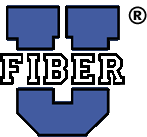
Free
Fiber U Self-Study Programs
FOA's
"Fiber U" free online self-study programs help you learn about
fiber optics, study for FOA certifications or use them to help
create "blended learning" classes. There are two new free online
self-study programs on Fiber
U. Fiber Optic Network Design is for those interested in
learning more about how to design fiber optic networks or
studying for the CFOS/D certification. FTTx is for those wanting
to know more about fiber to the "x" - curb, home, wireless, etc.
- or studying for the CFOS/H certification.
Got to Fiber U
for more information.
Fiber U
Online Self-Study Programs Offer Option Of Certificate of
Completion
FOA has
been offering quite a few free online self-study programs on Fiber
U, our online learning site. We are always getting
questions about getting a certificate for completing the course
online, so we have setup an option to take a test online and get
a certificate of completion for these online courses.
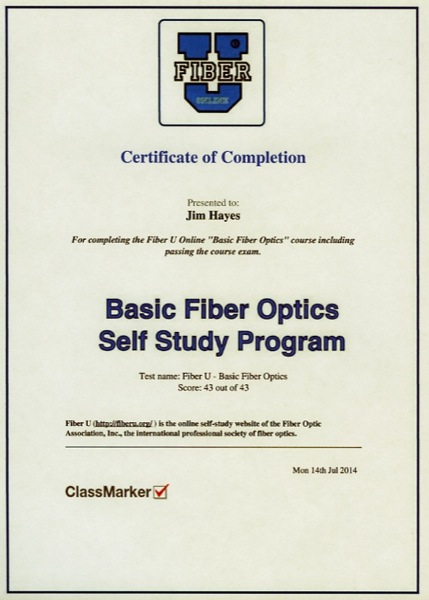
While it's not FOA certification, FOA will recognize a Fiber
U Certificate of Completion as background experience to
qualify for applying for FOA certifications. We also intend to
expand the program to more specialized topics as preparation
for FOA specialist certifications.
If you have associates that want to get started in fiber,
have them take this course online to get started. Go to Fiber
U and get started.
Lennie
& Uncle Ted Now Available As Free Books on iTunes


Lennie
Lightwave's Guide to Fiber Optics and
Uncle
Ted's Guide To Communications Cabling
are now available free to iPad users who can download them from
the Apple iTunes store. Of course they are still available
online or for download.
Lennie's
Guide has always been the world's favorite introduction to fiber
optics. It was first published in the mid-1990s by Fotec, the
fiber optic test equipment company famous for its "Fiber U"
training conferences and more than 60,000 printed copies were
distributed. Lennie was one of the earliest commercial webpages
and is still online today (and as popular as ever) at http://lennielightwave.com.
Uncle Ted's Guide was
created at the request of Lennie readers who wanted a similar
simple introduction to "Cat 5" wiring. This latest version of
Uncle Ted's Guide covers the all premises cabling topics -
wiring, fiber and wireless.
You can find these free guides on Apple's iTunes Store or on the
FOA website - go here for all the links: Lennie
Lightwave's Guide to Fiber Optics and Uncle
Ted's Guide To Communications Cabling
FOA
Textbook Now Available in French / FOA manuel disponible
en français
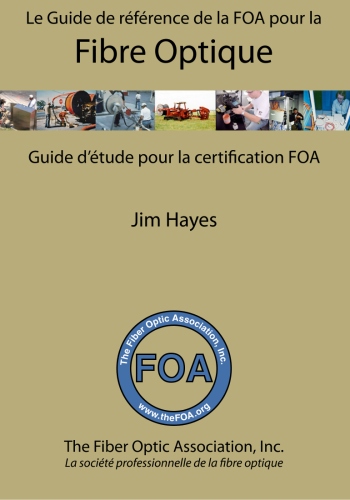
Available
from Amazon.com / Disponible
sur Amazon.com
And
from Createspace / Et
à partir de Createspace
FOA Now
Offers Fiber Optic Textbook In Spanish
Guía de
Referencia de la Asociación de Fibra Óptica (FOA) Sobre Fibra
Óptica
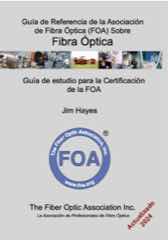
- Reference
Books for FOA Certifications available on Kindle and
iPad/iPhone as well as printed
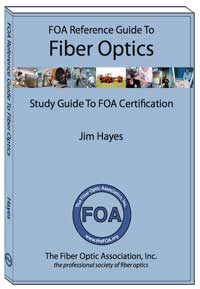
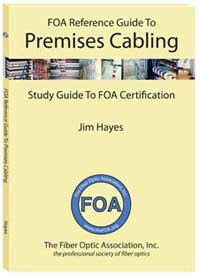
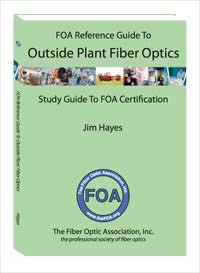
We have created three new FOA books to be used in training for
FOA certifications and as reference books for contractors,
installers and end users of fiber optics. These books have
full curriculum support, including free curriculum materials
for teaching FOA certification courses. Because we are
self-publishing these books using more modern "publish on
demand" technology, they are easier to keep up to date, easier
to buy and much, MUCH cheaper!
All
are now available in print and electronically in Kindle and
Apple iBook versions. The basic fiber optic book is also
available as a self-study program in an Apple APP for
iPad/iPhone/iPod.
Details on the new book each of the new books are at the book
pages linked to the photos above.
RETURN
TO INDEX
FOA
iPad Apps
FOA
LossCalc
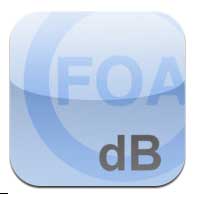 FOA
LossCalc estimates the optical loss of a fiber optic link. This
will save time for the installer of a fiber optic link needing
to know whether test results are reasonable and/or make a
"pass/fail" determination. It can also help the designer of a
link to determine if communications equipment will operate over
this link. FOA
LossCalc estimates the optical loss of a fiber optic link. This
will save time for the installer of a fiber optic link needing
to know whether test results are reasonable and/or make a
"pass/fail" determination. It can also help the designer of a
link to determine if communications equipment will operate over
this link.
By choosing the type of link (singlemode or multimode) and
specifying the length of the fiber and numbers of connections
and splices, it will calculate the end to end loss of the link.
The app has default specifications for singlemode and multimode
links or the user may create custom setups with specifications
appropriate for any application. http://itunes.apple.com/us/app/foa-losscalc/id476262894?mt=8&ls=1
Self -Study in Fiber Optics
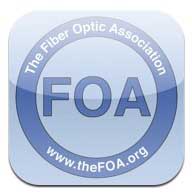 Our
first app is a self-study version of the FOA Reference Guide to
Fiber Optics. The FOA APP builds on the FOA basic fiber optic
textbook to create an interactive learning environment that
builds on the iBook electronic version of the book to add a
guide to use for self-study and real-time testing that provides
feedback on what you have learned and correct answers to
questions answered incorrectly. Our
first app is a self-study version of the FOA Reference Guide to
Fiber Optics. The FOA APP builds on the FOA basic fiber optic
textbook to create an interactive learning environment that
builds on the iBook electronic version of the book to add a
guide to use for self-study and real-time testing that provides
feedback on what you have learned and correct answers to
questions answered incorrectly.
The FOA APP is priced at only $9.99, same as the iBook, so the
self-study program is free. Download it from the Apple APP Store
with your iPad or iTunes.
http://itunes.apple.com/us/app/foa-guide/id434354283?mt=8&ign-mpt=uo%3D4
RETURN
TO INDEX

The
FOA has many videos on  ,
including two Lecture Series (Fiber Optics and Premises
Cabling), Hands-On lectures on both and some other informational
and instructional videos. For all the videos, go
to the FOA Channel "thefoainc" or use the direct links
below. ,
including two Lecture Series (Fiber Optics and Premises
Cabling), Hands-On lectures on both and some other informational
and instructional videos. For all the videos, go
to the FOA Channel "thefoainc" or use the direct links
below.
View
a complete list of FOA Videos with links to each video on
YouTube.
For End Users - Who Think Fiber
Needs Maintenance
FOA
Lecture 39 Maintaining Fiber Optic Networks
FOA Product Demonstrations
In the June FOA Newsletter, we talked about the new 3M
"disposable" cleaver, the Easy Cleaver, which is provided free
with 3M connectors and mechanical splices that need cleavers. We
got samples of the Easy Cleaver from 3M and tested them
ourselves, and they work great. You can see for yourself how
they work in this FOA
YouTube Video about the Easy Cleaver.
We also tested the new Ripley/Miller FO-CF Center Feed Fiber
Stripper and used it as an opportunity to show the other three
common types of strippers, the Miller, MicroStrip and NoNik and
how they are used. So you get a review of how to strip fiber and
a product review of the new stripper in this FOA
YouTube video about fiber strippers.
New FOA Lectures - Jargon and
Jobs
How to
Talk Fiber Optics - an introduction to fiber optic jargon
- the perfect place to start learning about fiber optics.
Where Are
The Jobs In Fiber Optics? FOA talks about all the
applications for fiber optics, what jobs involve and the
qualifications for the workers in the field.
What's A "Network"
That's a common question from fiber and cabling people. Even
though they may be installing the cable plants for networks,
often the nature of networks is not something they have been
exposed to, other than perhaps the catch-all "star network"
description. But what is a network? What does it connect? How
does it connect users and how does it allocate the bandwidth to
them? How do various network types vary?
We've been working on some new YouTube videos on networks,
starting as we usually do on a new subject with the basics. We
have these three videos online now, but watch for more.
Fiber
Optics - Live! A
series of videos that use lab demonstrations to show how
optical fiber works.
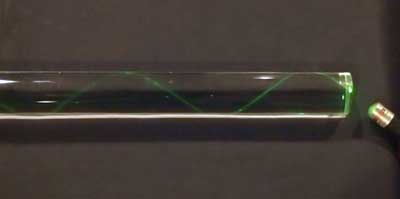
Prepolished/Splice
Connector Termination (Panduit OptiCam)
Cabling
Project Management - what's involved in a
copper/fiber/wireless project -advice for the customer and the
contractor
Hazards
Of Counterfeit Cable
You may
have read the stories we have written about the counterfeit
"Cat 5" cable made from copper-clad aluminum rather than pure
copper. Recently we tried an unscientific burn test on the
cable compared to a known good UL tested cable and posted a
video on YouTube. You can see the results below.
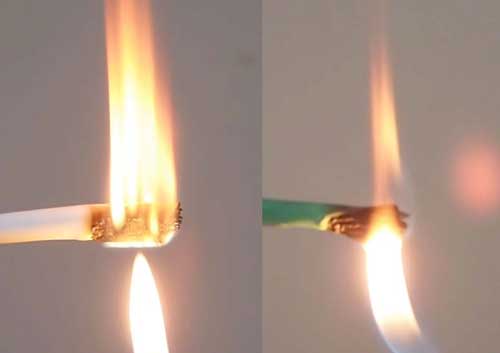
Counterfeit
Cable Real UL-rated cable
The
difference is obvious and the danger is real. Watch the video
on YouTube: Premises
Cabling Lecture 11: Counterfeit Cat 5 Cabling
View a
complete list of FOA Videos with links to each video on
YouTube.
View
all the FOA Channel on YouTube.
RETURN
TO INDEX

What's
New in the FOA Online Fiber Optic Reference Guide?
We are
continually updating the Online Reference Guide to keep up with
changes in the industry and adding lots of new pages of
technical information. Go to the FOA
Guide Table of Contents to see the latest updates - look
for  . .
FOA
Guide page on Metrology-
the accuracy of measurements
Fiber
For Wireless: FTTA
and DAS
Updated page on Data
Centers
Le
Guide de référence pour la fibre optique de la FOA est
maintenant disponible en français.
Updates
for new FOA certifications in FTTA
and Data
Centers
What do you do when you need to test fiber or
cable on a reel? Here is a new page on Bare
Fiber Testing
Couplers or splitters are used in FTTH and OLANs. How
do you Test Splitters?
Tapping fiber has been a big topic in the news. How
do you tap fiber?
The page on Optical
LANs (OLANs) has been expanded with new material and
links.
What's
A Network? A simple explanation of network types and
operation has been added to the FOA Online Guide.
We
have updated the
"Datalinks"
page.
Three
"Quickstart Guides" for fiber optic testing: cable
plant & patchcord loss, power
and OTDR
Learn
More About OTDRs - Download a Free OTDR Simulator
More and more installers are being asked for OTDR testing but
using these instruments is not easy. They are hard to set up
properly and complicated to interpret the traces. Using the
autotest function can lead to disastrous results! The FOA has a
good tutorial on OTDRs on our Online Reference Guide and we
added a free download of an OTDR
simulator to the OTDR
section so you can learn how to use an OTDR on your PC.
More
New Info:
Links
to manufacturers
and distributors of fiber optic lighting products.
The
FOA Online Fiber Optic Reference Guide has become very
popular - perhaps the most popular technical website ever,
typically with over 360,000 users downloading about 1.75 million
pages in 2011! We continue updating materials regularly, keeping
it as up to date as possible.
Find
What You Want Using "Google Custom Search
 There's
so much information on the FOA Tech Topics and Online Fiber
Optic Reference Guide that even a well-organized Table of
Contents isn't enough and when the material is always changing,
an index is impossible to maintain. So the FOA is using the
latest technology in search, Google Custom Search, which will
allow you to search just the FOA Tech Topics and
Online Fiber Optic Reference Guide for any topic you want to
find more about. Try
it! There's
so much information on the FOA Tech Topics and Online Fiber
Optic Reference Guide that even a well-organized Table of
Contents isn't enough and when the material is always changing,
an index is impossible to maintain. So the FOA is using the
latest technology in search, Google Custom Search, which will
allow you to search just the FOA Tech Topics and
Online Fiber Optic Reference Guide for any topic you want to
find more about. Try
it!
Go
to The
FOA Online Fiber Optic Reference Guide.
RETURN
TO INDEX
New
Schools
The FOA welcomes the newest additions to our listing of FOA-Approved
Training Organizations:
Owensboro
Community and Technical College, Owensboro, KY, USA. School
# 358
Ashalnd Community & Technical College, Ashland, KY, School
# 359
Find
a listing of all the FOA-Approved schools here.
Find
An FOA-Approved Training Organization
Most
inquiries we get regarding finding a FOA-Approved training
organization want to know two things: what school is closest to
me or what school offers the certifications I need. The FOA has
about 200 training organizations we have approved worldwide so
finding the right one can be difficult! We've been looking at
ways to make it easier, and we think we've got a good solution.
In fact we have two solutions.
First we have added a sortable
table of all the FOA-Approved schools.
You can also use our FOA
Google Map to find FOA-Approved schools.
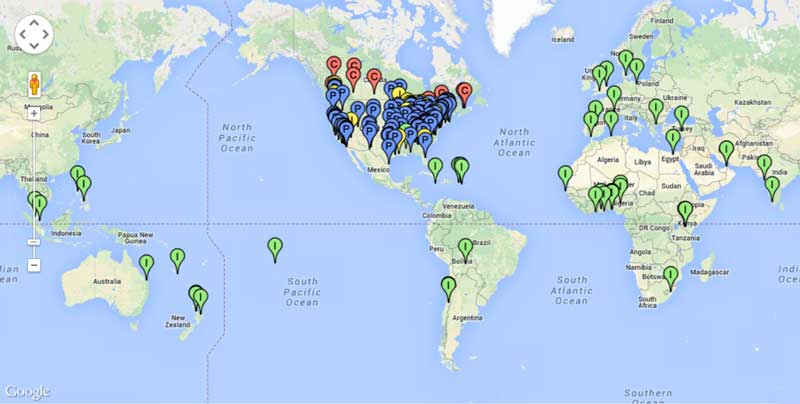
What
Should A Fiber Optics or Cabling Tech Know and What Skills Do
They Need?
FOA
certifications are based on our KSAs - the Knowledge, Skills and
Abilities that techs need to succeed. Read the FOA KSAs
for fiber and cabling techs.
School News
Feedback
We always
enjoy feedback, especially when it shows how great some FOA
instructors are. These came from students of Tom Rauch, an
instructor at BDI
Datalynk:
"I took your fiber optics certification courses this past March.
I just wanted to let you know that in two weeks I start working
as a fiber optic technician with ___ up in ___. You mentioned on
the first day of the course that there is always one guy in
class who had rubbed his last two nickels together to be there
and, in that instance, I was that guy. Now I'm going to be able
to provide for my family like never before and I owe it to the
certification that I received from you and BDI Datalynk. I just
wanted to thank you again."
"Thanks to our tremendously knowledgeable and patient instructor
Thomas Rauch, who was not only generous in sharing his wealth of
information, but he did so with ease, humor and in a way that
invited curiosity and participation. He was encouraging and
proud of our accomplishments and helped us learn from our
mistakes in a way that did not break our confidence, rather it
pushed us to better results the next go around. The hands on
labs were just AWESOME!" Just thought you should know what a
class act you have representing you in his travels..... but then
again you probably already knew that! : )
In almost 19 years at Verizon and having held numerous
positions, I have gone through many training sessions. I cannot
remember ever having been actually looking forward to coming
back to class quickly after lunch, to get back to the hands on
activities, and walking away with the sense of empowerment that
the information presented was not only relevant but dead on
point accurate! I will be signing up for the Outside Plant class
on March! I can't say enough good things about Tom and his
impact! Feel free to quote me, I can only imagine that he will
open so many doors and change so many lives in the years to
come, with his style of teaching! Great experience, awesome job!"
IBEW
and FOA Partner on Fiber Optic Training
The
International Brotherhood of Electrical Workers (IBEW) and the
National Electrical Contractors Association(NECA) through the
National Joint Apprenticeship and Training Committee
(NJATC) in
a partnership with the FOA has published a new textbook for
training IBEW apprentices and journeymen in fiber optics. The
new textbook uses the material from the FOA Reference Guide To
Fiber Optics with new material and photos from other NJATC
training partners.
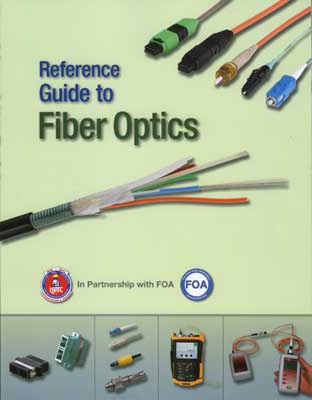
FOA is pleased to have been able to assist the NJATC in the
development of this new text. FOA has been a NJATC training
partner for many years, including offering instructor training
at more than 16 of the NJATC's summer National Training
Institutes. A majority of IBEW NECA contractors do fiber optics
and low voltage, especially for applications that combine
electrical and communications cabling like smart grid,
alternative energy, traffic controls, data centers, etc.
Quote
from one of our certified instructors: I want to thank
you and your organization for all the resources you provide for
the students and the opportunity to offer the certification to
the students. The fact that you published the book yourself to
get the cost down and the unlimited free resources on your
website shows a commitment to the public that is second to none.
I let it be known to the students that the FOA is the best in
the industry at supplying knowledge and resources related to the
communication industry. I look forward to passing on the
information that you provide for the industry.
Great
Video About An FOA School And Their Training
BDI
Datalynk trains at the Unversity of Central Florida. UCF
created this incredible video on the BDI Datalynk program.
It shows the power of what they
offer on campuses around the US.
Watch the video here: http://www.ce.ucf.edu/Program/2583/Fiber-Optics-Network-Certification-Courses-Non-credit/
For more information, contact Bob Ballard, CFOS/I, BDI DataLynk,
LLC, A Vietnam Veteran-Owned Company
www.bdidatalynk.com,
Ph: 512-785-9024
RETURN
TO INDEX
Good
Question! Tech Questions/Comments Worth Repeating
Real
Questions From FOA Newsletter Readers
MPO
Connector Loss
Q: Is there a current standard, for maximum allowable
loss, for MPO fiber connectors? If so… what is the standard #
from EIA/TIA? (Was it amended in 568B, since they were
introduced?) Would it be similar to standard connectors @ 0.75dB
Max allowable loss?
A: The MPO is covered
under the TIA 568 standard. All fiber optic connectors are the
same - 0.75dB.
There are discussions being held at TIA and ISO/IEC on using a
different method of specification, statistical in nature, that
says X% would be less than YdB in several stages from 0.1-0.2 to
over 1dB, but it’s led to some headed discussions.
MPOs for MM are probably no less than 0.5dB and SM are near the
0.75dB mark. At least the SM ones are APC (usual 8 degrees, but
still a flat polish).
I’ve recently learned that MPOs are polished for fiber
protrusion to try to get fiber contact, but the evenness along
the line of fibers is harder to control.
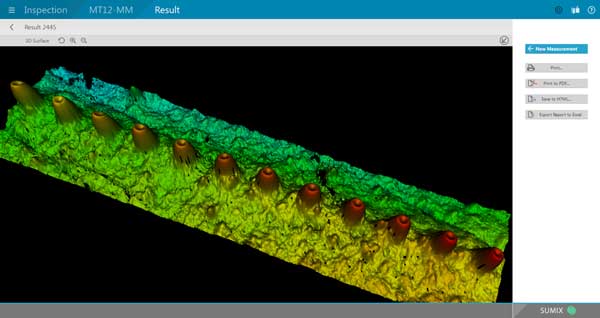
image from SUMIX
showing protruding fibers in MPO connector
Reflectance
and OTDR Measurements
FOA
often gets questions from the field that are complicated
technical issues compounded by misunderstandings of product
performance and testing limitations. Here is an example from
recent conversations about a real world problem.
Here's
The Question:
In a project, the customer is requiring a contractor to test
connector reflectance and requiring -55dB for each
connection. They are using fusion spliced pigtails with
UPC factory connectors. They are measuring with an OTDR,
but they can’t seem to meet the -55dB reflectance requirement on
the connectors. They are getting (-51dB – (-54dB) on a
consistent bases and continually cleaning and inspecting.
I told them going into this that on the lengths of fiber they
are measuring they will have a hard time getting individual
reflectance measurements to meet the -55dB value unless they use
angled polished connectors. The lengths are 2,000’ –
9,000’+ and the way OTDRs measure reflectance will make it hard
to get that precise.
I am having them take the OTDR out of “auto” mode and shorten
the pulse width and increase the averaging time to try and get a
little more accurate measurement, but still not sure that is
going to fix the problem.
Any suggestions?
Background: How an OTDR
Measures Reflectance
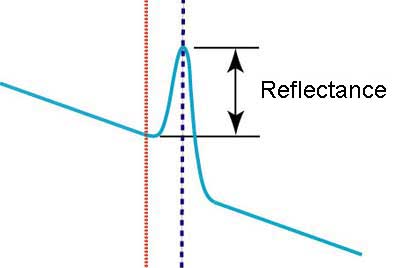
Answer:
In this case, we’re looking at UPC connectors. They are
generally specified as ~ -45 to -50dB reflectance, and that can
be +/-5dB because the reflectance can’t be measured that
accurately, especially at that level.
A reflectance of -55dB means that a few parts per million of the
incident light is being reflected. To make the measurement, you
have to measure that reflected light against the backscatter
level. Both are low level, in this case -55dB reflectance level
and ~ -75 to -77dB backscatter level. The OTDR is basically
trying to measure a few PPM compared to a signal 100 times
smaller!
If you reduce the pulse width the amount of power in both
decreases significantly making the signal/noise ration worse.
With signals this small, you are working near the noise level of
the instrument and no amount of averaging can improve the
signal/noise ratio enough to get an accurate measurement. I’ve
never done actual tests with an OTDR myself to get statistics,
but I’d bet the measurement has an uncertainty of much more than
+/-5dB.
Furthermore, you must be cautious with selection of pulse width.
In a Corning
document on reflectance, they say the amplitude of a
reflective feature on an OTDR trace appears larger when measured
by shorter pulse widths and therefore are often misinterpreted
as a cause for concern during cabling or installation
measurements.
If the customer really wants or needs -55dB, they really
need to use APC connectors where the angle polish all but
eliminates reflectance. That’s what we’re seeing in most short
SM applications today (FTTH, pas
How Long Does It Take To
Transfer Data Over Fiber?
Q: Have there been any studies that show how long it
takes for data to travel over a fiber cable where the point of
origin is 500 miles away vs. a point of origin that is 5000
miles away?
A: There are several
parts to the answer, including travel time in the fiber, the
length of the data packet and processing time in the
transceiver:
1. Distance = velocity X time
Light in a glass fiber travels at the speed of light
(c=299 792 458 meters/s) divided by the index of
refraction of the glass (1.4677 @ 1310nm, 1.4682 @ 1550nm). For
long distances, 1550nm is used, so the speed of light in the
fiber is about 204,190,476 m/s - “about” because of some
secondary factors, so let’s say 204,000 km/s.
That’s about 4.9 ns/km or 4.90 ms/1000km from point A to point
B.
2. Then the speed will depend on the data speed of the network.
Obviously a system at 1Gb/s will take ~10 times longer to
transmit a packet of data than a system at 10Gb/s and ~100 times
longer than a 100G system. This speed also depends on the
protocol of transmission which determines the overhead of
transmission. Thus a 1000 byte packet has 8,000 bits and will
equal about 10,000 bits with overhead.
To transmit a 1MB file, it requires 1000 packets and
will take ~10Mbits of data, equalling 10milliseconds at
1Gb/s, 1millisecond at 10Gb/s, and 0.01 ms (10microsec) at
100Gb/s.
3. Processing time in transceivers and multiplexers. Data is
usually processed in parallel but transmitted in serial. The
conversion takes some time. Some transceivers also do some pulse
shaping which may take time. Then there are transit times to get
parallel data transmitted throught amps, lasers, (then the fiber
link) to a detector and amps and demultiplexers on the other
side.
This is hard to predict times, but it’s ~nanosecs to microsecs.
Lets say 1microsecond
For your comparison of 500miles vs 5000miles, for convenience,
lets say 1000 and
10,000km, in transmitting our 1MB file
at 1Gb/s
1000km - 4.9ms on the fiber + 10ms + 1microsec = 14.9ms
10,000km - 49ms + 10ms + 1us = 59ms
at 10Gb/s
1000km - 4.9ms on the fiber + 1ms + 1microsec = 5.9ms
10,000km - 49ms + 1ms + 1us = 50ms
at 100Gb/s
1000km - 4.9ms on the fiber + 10microsec + 1microsec =
4.91ms
10,000km - 49ms + 1microsec + 1us = 50.002ms
More Than “Single” Mode?
Q: We're now using SM fibre so it looks like we don't
need mandrels in the Ref Lead at the Light Source. The
info I have is that we need to make a couple of air coils 35mm
to 50mm in diameter. Why?
A: When you launch from
a pigtial laser source through a connector into a reference
cable, you do have several modes being propogated. It usually
takes 100m or so for the second or third order modes to
attenuate. So the coil causes them to be attenuated by the
stress enough to no longer be significant - it’s a mode filter
just like MM. If you do not do this, you will measure higher
loss in the fiber and at connections near the source. Since most
SM has traditionally been long distance, the effect was small or
ignorable, but with short links, it can be significant.
Followup Q: But how do we explain multiple modes in Single Mode
fibre?
A: When you get the core of the fiber down to ~5-6 times the
wavelength of the light, it no longer acts like geometric optics
(like MM fiber). Some of the light can travel outside the core
(see the note on “waveguide
dispersion”here http://www.thefoa.org/tech/ref/testing/test/CD_PMD.html).
At launch, significant amounts of power are at higher angles
creating short lived modes that are highly attenuated.
Replacing OM1 MM Fiber
Q: We are an automation system integrator in South
Africa. We have a client that has multimode 62.5/125 fibre optic
plant wide. None of the runs between components are longer than
2km. We intend to upgrade the technology from a proprietary
communication protocol to a standard ethernet protocol at 100
MHZ. The fibre to copper convertors we will be using are using
1300nm light source and have a Fibre Optic Link Budget of 12.8dB
for 62.5/125 um and 9.8dB for 50/125 um. The
client has been advised to replace the multimode 62.5/125 with
multimode 50/125 cabling and we need to know if this is really a
requirement.
A: Do you know how old
the fiber is? It should be what we called FDDI grade 62.5/125
fiber with a loss of ~1dB/km and a bandwidth of 500MHz-km
at 1300nm. A 2km link should have a loss of 2dB for the fiber
and ~0.5dB/connection - well under the power budget of the link.
100Mb/s Ethernet variants were designed for 2km or more on this
fiber. There is no reason to upgrade at this time, 50/125 fiber
would not be needed until Gigabit Ethernet was desired.
Bi-Directional OTDR Testing
Q: Should the testing be done with the same piece
of equipment from both ends then merge the results or does that
not matter - can you use traces from two OTDRs as long as the
test equipment is compatible and settings are adjusted properly.
A: Yes, you should use
the same test set from each end but this way - take a trace,
disconnect the OTDR from the launch cable and go to the far end
of the receive cable and connect it there to take the second
trace. The usual way people do bi-directional tests is to
disconnect the launch cable and take it to the far end and shoot
back up, often not using a receive cable at all, figuring they
get the far end connector on the second test. But when you
disconnect the launch cable (and/or the receive cable) you lose
the connection you want to test in the other direction! As for
using the same OTDR, every OTDR is different and the results you
get may be significantly different, esp. if they are not
calibrated recently - and few OTDRs are ever calibrated.
Tracing Fibers
Q: I’m looking for an inexpensive, but reliable method
to quickly and easily identify terminated and unterminated SM
and MM fiber, perhaps something similar to a tone and probe used
for copper cabling. For example, I found a unterminated
coiled fiber cable and would like to use it, but there are
several unlabeled, terminated and unterminated fiber cables at
the other end. Is there an inexpensive universal tool to
simply and easily find the cable/s I’m looking for?
A: Your best bet is a
visual fault locator (VFL) but you do not need a bare fiber
adapter, just a unterminated connector. You will need to strip
the fiber and preferably cleave it, but that can be done off the
end of the connector. Just scribe the fiber and pull straight
away from the connector. That should give a cleave good enough
for using a VFL to trace fibers.


Equipment
Specified At 1310nm and 1300nm Compatible
Q: Can a switch or SFP module specified at 1310nm GBIC
connect to another switch or SFP that has is specified at 1300nm
GBIC?
A: No problem - there
is no material difference in 1300nm and 1310nm - it's just
jargon. The 1300/1310nm confusion has been part of fiber optics
for 30 years. Basically, there is no real difference in the
wavelengths except for traditional nomenclature. The
nomenclature evolved to this - if you said 1310nm, it was
assumed you were talking about lasers, but if you said 1300nm,
it was assumed you meant a LED!
Color Code For Hybrid Cables
Q: Is there a standard color code for the jacketing of
a hybrid all optical cable, one that has both single mode and
multimode optical fibers in it?
A: No, it has to
be spelled out on the cable. We could use a standard however. We
know plenty of people who got SM and MM confused in a hybrid
cable.
Passive
OLANs in Hotels And Resorts
Q: Are passive OLANs a good choice for hotels or
resorts?
A: Passive Optical LANs
are enterprise networks based on fiber to the home (FTTH)
technology not Ethernet over structured cabling. The FTTH
network is usually using GPON standard equipment over one
singlemode fiber with passive optical splitters that provides
basic Level 1 and 2 network functionality. This is not Ethernet
but carries Ethernet over the GPON protocols at 2.5G downstream
and 1.25G upstream.
Passive OLANs offer several advantages over conventional
Ethernet switches and structured cabling, including much less
cost (~50% capital expense and ~20% operating expense),
much lower space requirements (see the link to the library
photos below and note the two racks of equipment that support
4000 drops), longer distance requirements (to 20km), easy
expansion (these are systems designed for hundreds of thousands
of users) and easy management (when you have hundreds of
thousands of users, that’s important.)
For hotels, convention centers and similar facilities, the ease
of upgrading to a passive OLAN is a big advantage - one fiber
goes from the computer room to a splitter where it can serve 32
switches of 4 ports each. That’s right, one fiber can support
128 users! It can support anything that a network can - wireless
access points, security cameras, secure entry systems, VoIP
phones or POTS phones - anything that will run over a
conventional network.
Equal Fiber Lengths in Duplex
Links
Q: In a fibre system using separate cables for receive
and transmit, do the cables need to be the same length. Do the
patch leads need to be the same length?
A: The answer is “no”
within reason. Duplex signals are asynchronous by design so a
small difference should not cause problems. For some protocols,
very large differences might be a problem, but certainly not the
small differences in fibers in a cable or patch cord variations.
Even in a long OSP loose tube cable, there are variations in the
length of fibers, as much as +/-1%, because the fibers are loose
in the cable to prevent stress, so at 100km, the difference
could be significant. Networks allow for this.
Mixing
OS1 and OS2 Fibers
Q: Can I splice OS2 pigtails to OS1 fiber?
A: OS1 and OS2 are
identical geometrically (same core and clad size) but OS2 has
been processed to remove more OH+ (water ions) to reduce the
attenuation at the water peaks for use with coarse wavelength
division multiplexing. See
http://www.thefoa.org/tech/ref/basic/fiber.html
There is no problem mixing them in a system because other than
the reduction of the water peaks, the fibers are the same and
can be joined with no excess loss.
Testing
Attenuators
Q: How do I test an inline attenuator (receptacle on
one end and connector on the other)?
A: Here is the
procedure to test an attenuator:
This attenuator only works properly between two cables to add
attenuation so if you test directly connected to a power meter
it may not be correct. Here is how it is used:
————————————C-AAAAC=C——————————
Where C is a connector, -AAAAC is the attenuator with a
receptacle on the left and a connector on the right, and = is a
separate mating adapter or receptacle. C———————————C is a cable
with connectors on each end. Source- is a source and -Meter is a
meter
Test it like this:
First measure the output of the source with a cable as
the “0dB” reference. Use at least a 2m cable and put a
50mm loop in the cable. Remember you need SC/APC connectors on
the cables mating to the attenuator.
Source-C——————50mm loop———————C -Meter
Attach the receptacle end of the attenuator to the cable, then
use a mating adapter to attach a second cable to the attenuator.
Attach the meter to the end of the second cable to measure the
loss.
Source-C——————50mm loop——————C-AAAAC=C————————————C-Meter
Be sure to put the loop into the cable attached to the source.
Be sure your two cables are low loss and everything is very
clean.
And here is the photo the person asking sent us when they did
the test:
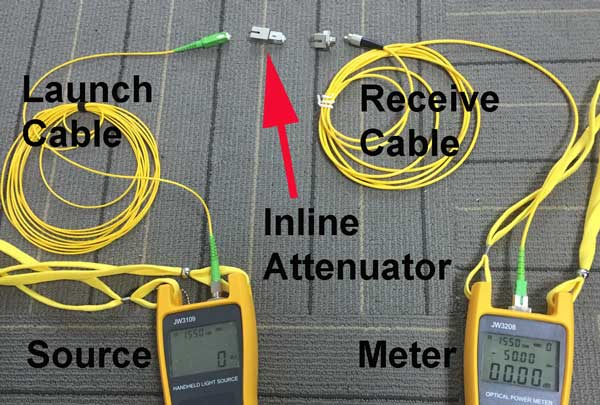
Calibrating
An OLTS
Q: I have a question about the OLTS - do you have to
recalibrate it every day ?
A: Any optical loss
test set needs to be calibrated for “0dB” whenever anything
changes - the launch cable - source output - or even every few
tests to ensure the connector is clean and undamaged - plus they
wear out. See 5
different Ways To Test Fiber Optic Cables.
Index
Of Refraction For Unknown Fibers
Q: I inherited some old fiber to characterize. How do I
set the IOR in the OTDR?
A: The
index of refraction is the spec the OTDR uses to calculate
length. If you refer to the data sheets of fiber
manufacturers like Corning (https://www.corning.com/media/worldwide/coc/documents/PI1463_07-14_English.pdf)
and Prysmian (http://www.prysmiangroup.com/en/business_markets/markets/fibre/downloads/datasheets/SMF---Enhanced-Single-Mode-Optical-Fiber-ESMF.pdf)
you will find that G.652 fiber has similar index of refraction
among most manufacturers - 1.467 @1310nm, 1.468 at 1550/1625nm.
If you do not know what the index of refraction is, using those
is probably a very good estimate. Remember the measured length
of fiber will be ~1% longer than the cable and you may have ~1%
uncertainty in the instrument measuring length.
Insertion
Loss
Q: I have not been able to find a good definition of
“optical insertion loss” or “insertion loss” or “optical loss.”
A: Insertion loss was
the term originally used for the loss of a connector tested by a
manufacturer. They would set up a source and length of fiber
connected to a meter, measure power, insert a pair of connectors
and measure the loss. Since it was an inserted connection, it
became known as insertion loss.
Over time, the term insertion loss became more widely used to
contrast with the loss measured by the OTDR, an indirect
measurement using backscatter that may not agree with the loss
with a light source and power meter.
Insertion loss, therefore migrated to meaning a loss measured of
a cable or cable plant inserted between the launch and receive
cables attached to a light source and power meter for double
ended testing used with installed cable plants. For patch cord
testing, you do not use a receive cable attached to the power
meter but connect it directly to the cable under test, making
the test just include the one connection to the launch cable.
Two other terms often mixed up are attenuation and loss, which
are essentially the same, except when discussing a fiber. In
fibers, attenuation is often used instead of attenuation
coefficient. Attenuation is the absolute loss i dB while
attenuation coefficient is the characteristic attenuation of a
fiber expressed in dB/km.
Here is probably the best explanations: http://www.thefoa.org/tech/ref/basic/test.html
Adhesive/Polish
Connectors
Q: If a connector is designed for heat cure epoxy
adhesive, can I substitute anaerobic adhesive?
A: Any ceramic ferrule
connector can be used with either heat-cure epoxy or anaerobic
adhesives.
Old Fiber
Q: We are looking at a company’s fiber network which
has been laid at various points in time over numerous
years. In this process, we are trying to identify the
changes that were made to either/both the glass fiber and the
cladding. Are there different generations of what was
industry standard in creating the fiber? For example, are
you able to identify the difference in a fiber that was laid in
1980 versus one laid today? Was the cladding the same
size/thickness etc. in 1980 as it is today or has this been
modified/improved upon over the years? In all, we are
trying to find what modifications have been over the years and
how this may improve the life of the network and its
capabilities.
A: This is a common
problem today. Many network operators are evaluating their fiber
networks for upgrades, hampered by the fact that few are
properly documented. Below is a timeline that should answer your
questions. What many network owners are doing now is testing
their cable plants - a process called Fiber
Characterization. There are contractors who do this
service.
Fiber
Tech Timeline
1976 -
First field trials, US and UK, using multimode fiber at 850nm
1980 -
First long distance networks still using multimode fiber at
850nm, planning to upgrade with wavelength-division
multiplexing at 1310nm
1984 -
singlemode fiber becomes feasible, telecom drops multimode
fiber, all future installations are singlemode - this first SM
fiber with a 9 micron core and 125 micron cladding is still
available today but with better specifications. Really early
fiber may not have good environmental protection and degrades
over time. Early speeds were 145-405Mb/s, up to 810Mb/s by the
end of the decade.
1990 -
around this time, modern fiber begins - better performance and
environmental protection. Fibers for wavelength-division
multiplexing in the 1500nm range appear allowing multiple
signals on a single fiber and fiber amplifiers allow long
spans.
1995-2000
- massive build-out of fiber backbone leads to glut of fiber -
WSJ ~2001 says 93% of all fiber is dark. Speeds grew from
1.2-10Gb/s over the 90s decade
2000-date
- massive Internet growth and mobile device growth eats up
glut of fiber and demands many times more. Dense
wavelength-division multiplexing becomes the norm. Speeds
began at 1.2/2.5Gb/s, upped to 10, 40 and are now at 100Gb/s.
So most fiber installed after 1990 has the possibility of being
used at 10Gb/s, after 2000, it’s probably OK for 40Gb, and since
2010, you are probably OK for 100G and maybe more. To
verify performance, you test each fiber for connector condition,
loss, spectral attenuation, chromatic dispersion and
polarization mode dispersion. There are test sets that will do Fiber
Characterization in basically one step.
Splicing
The Right Fibers
Q: I have been given a job that will require me to cut
an existing 6 count cable in two and splice in a new piece. My
problem is that this cable was installed in 1987. From what I
have been told there is a good possibility that this cable does
not follow present day color codes. Rumor has it that this cable
has 3 pairs of Red/White fibers. I was wondering if those pairs
are separated by a string or what? Otherwise I will be guessing
as to what fiber I am working on. Any information you have on
this old fiber type would be greatly appreciated.
A: Color coding for
optical cables is unpredictable except for the 1-12 color codes
adopted from electrical standards.
I suggest you head to one end of this cable or the other and
look at the ends where it’s terminated - you may be able to see
how it’s color-coded there. If not, you have two ways to
identify fibers other than color coding. 1. Use a visual fault
locator if the cable is short enough from the end to the splice
point - about 4-5 km is the max. 2. There is a gadget called a
fiber identifier that can clip on a fiber and see if there is
traffic or 2kHz tone from a test source. Both instruments are
described here: Fiber Optic Test Instruments http://www.thefoa.org/tech/ref/testing/Instruments/instr.html
Ethernet Switches In A Passive
OLAN
Q: I’ve design a POL (passive optical LAN) for a 39
level building for renting office area to enterprises. The owner
will provide “ONTs” to office area where the renters should
prepare network switches by themselves. Two questions pop up in
my mind:
1. If the renter buys an Ethernet
switch, can this switch be directly pugged onto POL’s fiber
terminals?
2. Or this L2 should be plugged onto ONT
of POL?
A: If I understand the
question correctly, you are asking if you can connect a L2
switch with an Ethernet port directly to a OLT. If the OLT uses
GPON and does not have Ethernet ports, the answer should be no,
GPON and Ethernet are not compatible so the Ethernet switches
should be connected to the Ethernet ports on the ONT.
Fusion Splicing Live Fibers
Q: Is it safe to fusion splice a live fiber, or is
there a chance that
the light from the arc will damage the detectors in the modules
at the end (20km-rated SM for us).
A: I have never heard of
this being a problem. The amount of light coupled into the fiber
from the splicing would be very small compared to a properly
coupled laser. When a cable is broken you might be splicing the
fibers that are live without knowing which are live and not
caring. On your newer splicers this is not a problem. On the
older splicers with the LID system you would have to reduce the
power to get a good splice which they would do by putting a bend
in the Fiber.
Estimating
Q: I need a source for estimating the cost of fiber
optic cable installations. Direct buried, in PVC pipe, Jetting
into existing pipe, etc.
A: FOA has a tutorial
on estimating fiber optics here: Estimating
Fiber Optic Installations
If you are looking for a consultant to do the estimates, I
suggest contacting a local contractor, distributor or consultant
who can do estimates.
Armored Cable In Conduit
Q: We will be pulling inside of an underground 2"
plastic conduit a 144 Strand OSP corrugated armored (coated
steel tape) fiber cable Corning 144EUC-T4101D20. The client is
asking what we are going to pull along with the fiber to allow -
if it is needed in the future- to locate the fiber. Does
an additional cable (like tracer wire) need to be pulled if the
fiber has already the coated steel tape ?
A: It is very unusual
to pull armored cable in conduit - that’s usually a
direct-buried cable laid into trenches or plowed in. The heavy
weight will make for a lot of friction and may create problems
pulling the cable. The armor on the cable should be suitable for
later cable location. It’s conductive and would be detectable
with many locators.
Upgrade
Systems But Still Use 100/140 Fiber
Q: If someone has fibre infrastructure based on
100/140um cable and wants to maintain the cable but update the
components on either end….. Do you know of a company who
has some sort of converter / adaptor for this type of
application?
A: 100/140 was replaced
by 62.5/125 fiber in the mid 80s after IBM used it on the 3044
Channel Extender (we helped IBM on that project.) Everybody was
scrambling to see if their equipment designed for 100/140 would
work on 62.5/125 fiber - and it worked just fine.
The larger fiber gather more light from the LED source so it
starts with more power and even if it loses a little at the
receiver from a small detector, the result is about the same. I
suspect the same is true for today’s equipment.
What you do not want to do is mix fiber types - there is a
substantial loss with the joining of 100/140 to 62.5/125 - see
Mismatched Multimode Fiber Losses Just make sure the patch cords
connecting the equipment are also 100/140 fiber.
Safety
Of Underground Fibre Cables
Q. The local phone company has approached me as
property owner, as they would like to lay fibre optic cables on
my property. I have been doing some research in an attempt to
establish the health risks involved with using fibre optics more
especially as I have minor children and the cables if laid, will
run along (underground - not sure how deep though) my pool area
where the kids play. Are you perhaps able to furnish me with
information regarding the exact health risks involved - short
term and long term please?
A: Fiber optic cable is
made from common plastics like polyethylene (PE) or polyvinyl
chloride (PVC) which is considered safe and used in many
household products. The fiber inside the cable is made of glass,
Hava purer form of the glass you use all the time. There is no
electrical current flowing, so there is no danger of
electrocution or exposure to electromagnetic radiation. The
light is not very strong and most systems shut off if the cable
has been cut. Cables are buried over 1m under the ground and the
trench for the cable is usually filled with gravel or cement.
For most homeowners the biggest problem is the destruction of
their lawn or garden during construction, but cable owners are
usually very good at fixing the problems and/or compensating the
homeowner.
Duplex
Communications Over One Fiber
Q: Is true duplex over a single fiber possible, or is
more like a shared time-domain technique in a quasi-duplex mode?
I would guess that true duplex would lead to interference
problems.
A. Bidirectional links
are widely used - that’s how FTTH PONs work. They use splitters
to combine/split the signals and one wavelength downstream and
another upstream. See Fiber
Optic Datalinks and for FTTH FTTH
Architectures.
Power
Wires In Fiber Cable?
Q: I would like to inquire if there is a fibre cable
combine with electrical cable to carry both data and AC/DC
voltage?
A: Many cable
manufacturers make so-called “composite” or “hybrid” cables that
include fiber an copper conductors. For example, a cable like
that is used for fiber to the antenna (see Fiber
to the Antenna (FTTA)). Contact your local cable
providers.
Passive
OLANs For Hotels?
Q: I would Like your opinion on a project I am
pursuing at one of my customers, a Hotel ,where the copper
analogue lines for the telephone are aging "about 30 yrs."
we would like to replace them with a PON ,and also be able to
push other services over the new cabling, could you give me the
names of some PON equipment manufacturers?
A: Great opportunity
for the Optical LAN. Then your customer is future proofed
and with unlimited bandwidth and an almost empty Telecom closet.
Tellabs, Zhone and Calix are doing hotel installations. It’s
even been done in India - see
this.
Using
Hybrid 2.5-1.25mm Connector Mating Adapters
Q. Can I use the hybrid 2.5-1.25mm adapters for
connecting SC connectors to LCs or MU connectors. It would make
testing much more convenient.
A: We do not recommend
them for most uses, especially testing, as they can be highly
unreliable. Reserve them for emergencies and use hybrid patch
cords instead.
Test MM Fiber @ 1300nm?
Q:
What is your opinion about the need for testing at 1300
nm on OM3 and OM4 fiber especially now that bend insensitive
multimode fiber is taking over?
A: It’s
unnecessary and costly. It’s rooted in the FDDI/100M days 25
years ago when 1300 LEDs were used and is now obsolete. The
only actual uses at 1300nm I know are the extremely rare
systems using 1310 lasers which may be standards but simply
don’t seem to ever be used. As you say, BI fiber makes the
issue of finding stresses moot.
Index Matching Gel In Connectors And Splices
Q: I would like to know if anyone has heard of or knows
of any issues pertaining to the Index Matching Gel in
prepolished splice connectors or mechanical splices getting
cloudy over 5-7 years and failing?
A: We have not heard of any problems with the index
matching gel failing over time. That gel is usually a silicone
compound that is highly stable and even if it were to cloud
there is only a few microns between the fiber ends, hardly
enough to cause a problem. There have been many papers written
on this topic and long term tests by manufacturers that show no
problems.
Fiber In Service Loops
Q: We designing a rural utility system that will be
expanded to FTTH (or FTTR - fiber to the ranch in this case).
We're wondering how much excess fiber in service loops to add.
One software package is asking for 12% but that seems excess.
A: I
have typically seen 100 feet on straight through boxes
(reserves), 35-50 feet on cut ends for splicing and anywhere
from 15-25 feet at the premise depending on how much is
required for the termination device, positioning, etc. When
rough estimating we have typically used 10% over linear
distance.
Cable For High Or Low
Temperatures
Q: When manufacturers specify cable for -30 - +70
deg C, are they talking operating or just installation
temperature for handling? Here the temperature can go as low
as -70 deg C.
A: The manufacturer
will specify a temperature range for the cable environment,
but the usual expectation is the install gets done in the
summer when it’s warmer. A plastic jacket at cold temperatures
is very stiff and hard to work with. Special cables for low
temperatures are available. We helped plan an install at
Scott-Amundsen base at the South Pole during the FOTEC days
and they are able to get special cable from most manufacturers
to test. It worked well.
Maintenance of Fiber Networks
Q: Can you guide me how to prepare Optical Fiber
Cable Annual Maintenance Proposal?
A: Basically, the
network needs to be installed properly, fully tested and
everything carefully documented. Then no routine maintenance
is required. Most problems with fiber optic networks occurs
when techs are working with it, e.g. damaging cables or
getting connectors dirty when testing, so leaving it alone is
the best plan.
Electronic transmission equipment can be tested anytime to
ensure proper data transmission, but that does not involve
accessing the fiber.
We have several things which may be of help:
You Tube Video: FOA
Lecture 39 Maintaining Fiber Optic Networks
Web page: Maintenance
I have 4 questions about OTDRs:
Q: What is dynamic range I read many time but
can’t understand yet, whether it is a range of losses can be
measured by OTDR for example if an OTDR has 45 dB dynamic range,
it can read the losses of point up to 45 dB or what it means.
A: I do not believe there is a standard definition of
dynamic range, but it is generally accepted to be the highest
loss of the longest cable where you can see the end of the
cable. That usually means using the longest test pulse and most
averaging and assuming the end of the cable has a
significant reflection.
Q: What is dead zone is it fixed in meters mean an
OTDR cannot measure up to initial 5, 10 or 20 meter
A: The dead zone is a function of the pulse width and
speed of the OTDR amplifier. For most OTDRs it’s about 2-3 times
the test pulse width.
Q: What Type of settings needed before launching a
test
A: See FOA
Lecture 18: OTDR Setup or the section "Modifying OTDR
Setup Parameters For Best Test Results” in
OTDR
testing. A: Basically you set up wavelength(s), test pulse
width (long enough to reach end of cable but short enough for
best resolution), index of refraction or group velocity (a
function of the fiber type and wavelength) and the number of
averages (enough to mitigate noise but not take too long)
Q: Reading a test with 1310nm and 1550nm - why values
different for a same length of fiber.
A: The attenuation of the fiber will be different at
each wavelength and the index of refraction which is different
at each wavelength causes a difference in length. The OTDR
measures length by measuring time and then multiplying that by
the speed of light in the fiber (which is the inverse of the
index of refraction.)
The FOA page "Frequently
Asked Questions About OTDRs" answers these
questions and more.
Getting
Old Cables Out Of Conduit
Q: How do you get old cables out of a conduit when
they are stuck?
A: Usually we are concerned about reducing friction
when pulling cables through conduit, but sometimes you need to
get them out. Here
is a page from American Polywater the leading lubricant
company with advice on the subject.
Manufacturing
Guide?
Q: Is there a guide published by FOA that provides
insight as to the process of fiber optic manufacturing? It's my
understanding that the guide stresses quality and controls to
ensure performance and reduce product loss?
A: We do have a guide
for manufacturers. It is mostly aimed at communications systems
and components manufacture. Here
is a link to download it.
How
Long Does Termination Take?
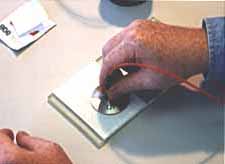
FOA received a request from a consultant recently wondering if
we had information on the termination times for fiber optic
cables. After some looking in our archives, we realized we had a
document online that compared times for various fiber optic
termination processes. The paper was written after several FOA
instructors did a comprehensive time and motion study on
termination processes. The document is about 15 years old but
still relevant.
You
can read it here in the FOA Online Guide.
Testing
Connectors (From A Patchcord Maker)
Q: What are the chief defining standard(s) that
specifies connector and assembly IL (insertion loss) and RL
(return loss or reflectance) for both SM and MM fiber?
A: The description on
our Guide is here: http://www.thefoa.org/tech/ref/testing/test/conntest.html
FOTP-34 covers connector testing as a qualification test
for the type of connector - basically a "destructive" test for
connector manufacturers.
Reflectance is described on that page and here also: http://www.thefoa.org/tech/ref/testing/test/reflectance.html
Testing an assembly like a patchcord is covered under
FOTP-107 http://www.thefoa.org/tech/ref/testing/test/FOTP-171.html
Basic
Tests For Fiber Optic Cable Plants
Q: I did some research and I noticed that there is a
bunch of tests that can be done to fiber optics and I was
wondering if there is a list of primary tests that can be done
as a basic test.
A: Fiber optic testing
does have a hierarchy of tests.
- At
the top of the list is "insertion loss" testing which uses a
light source and power meter to test the fibers in the
same way that a communications system transmits over the
fiber. It is a simple test and the equipment needed is
inexpensive.
- Techs
will also use a microscope to inspect the fiber optic
connectors for dirt and damage, a big issue for fiber.
- The
instrument called an "OTDR" takes a snapshot of the fiber
using a technique like radar. Most outside plant cables are
tested with an OTDR and the data ( the snapshots are called
"traces") stored for future reference. OTDRs are more
expensive and require more training to use properly.
Here is a
link to a page on the FOA Guide site that explains the
technical,details: http://thefoa.org/tech/ref/testing/test/OFSTP-14.html
FOA also has information just for users of fiber optic networks,
see http://thefoa.org/tech/guides/UG3.pdf
How
to Clean POF (plastic optical fiber)
Q: I
heard that plastic fibres such as PMMA can suffer damage from
cleaning from an alcohol solution. Are there alternate cleaning
solutions available for these types of fibres."
A: You can use a 10/90
mix of isopropyl alcohol/water. Typically use with a lint
free swab. (from out POF consultants)
Testing
Bare Fibers With OTDR
Q: We are starting to test some OPGW cables. We have an
OTDR but we don’t find some reusable connectors. If we have to
test an OPGW with 48 fibres, we can’t set up 48 SC connectors!
Are there some reusable connectors in the commerce?
A: I assume you mean you
need to test with a bare fiber on the OPGW. For testing bare
fiber, use a splice, not a connector. Have a long pigtail on the
OTDR as a launch cable, long enough for the test pulse to
settle, say 100-500m, then use a splice for a temporary
connection. You can fusion splice the fibers then cut the splice
out or use a removable splice like the Corning Camsplice
(http://catalog.corning.com/opcomm/en-US/catalog/ProductDetails.aspx?cid=&pid=17929&vid=18219)
If you use a mechanical splice, you need a high quality cleaver
just like with fusion splicing and after several uses, you need
to add more index matching gel or liquid - mineral oil works OK.
See
the FOA page on Testing
Bare Fiber.
Is A Flashlight Test Adequate?
Q:
I contracted a firm to install an OM3 of 200 meters. On
one end I have an SFP 1000SX ,on the other a 1000SX
converter from optical to UTP. We made pings but they never
reached, and I didn’t see the laser at the extreme of the fiber.
They promised me to send me the certification they supposely
made ,though they assured me the fiber is ok, because WITH
A FLASHLIGHT THEY SENT WHITE LIGHT FROM ONE SIDE TO THE OTHER
AND IT WAS VISIBLE. I saw the light too, and I thought the
culprit was my switch or my SFP. I want to know: is this a good
demonstration that the fiber is ok?
A: A visual continuity
test is not adequate - your eye is not calibrated! The power of
the lamp is unimportant as each eye’s sensitivity is different.
And your eye probably cannot see the light from a 850nm VCSEL
source - most people’s eyes are not sensitive at that infrared
wavelength. The installer should have tested the link with a
light source and power meter (http://www.thefoa.org/tech/ref/testing/test/OFSTP-14.html)
and given you the loss in dB. The connectors should also be
inspected with a microscope to ensure proper polishing and
cleanliness
(http://www.thefoa.org/tech/ref/testing/test/scope.html). If the
SFP output is -6dBm, what is the power at the receiver?
1000base-SX is supposed to work with 4.5dB loss (see
http://www.thefoa.org/tech/Linkspec.htm). The fiber loss should
be ~0.6 dB, so you must have >4dB connector losses! That says
bad installation! The 1000SX link should work over 200m if the
fiber has been properly installed.
Older Fiber?
Q: I have some 62.5 mm and sm inside fiber plant over
20 years old. When is a good time to upgrade?
A: When you need to or
have to. If it's working OK, there is no need to upgrade!
"Connector Loss" or "Connection
Loss"
Q: I have always counted the loss of a connector as .75
dB (568B-3) and 1.5 for a mated pair. Is that correct?
A: While the industry
always says "connector" loss, it is actually "connection" loss.
As we explain in the page on termination and splicing (http://www.thefoa.org/tech/ref/basic/term.html)
When we say "connector" loss, we really mean "connection" loss -
the loss of a mated pair of connectors, expressed in "dB." Thus,
testing connectors requires mating them to reference connectors
which must be high quality connectors themselves to not
adversely affect the measured loss when mated to an unknown
connector. This is an important point often not fully
explained. In order to measure the loss of the connectors
you must mate them to a similar, known good, connector. When a
connector being tested is mated to several different connectors,
it may have different losses, because those losses are dependent
on the reference connector it is mated to."
The
TIA spec of 0.75dB is for a mated pair of connectors. If you
have been passing connectors tested @ 1.5dB loss....you may have
some very bad connectors in your cabling!
Microscope
Magnification (11/13)
Q: I am doing a lot of fiber optic jumpers for control
systems, either single mode or multimode. I want to get a
scope to inspect the ends after I clean them would you recommend
a 200X, 400X handheld or one similar to a Noyes OFS 300
200C?
A: We prefer to use
lower magnification and have a wider view so I can see more of
the ferrule to determine its condition. You can see the fiber
effectively at 100X but 200X may be better. 400X may be too much
for most tasks like inspecting for cleanliness, but may be good
if you are polishing SM for good reflectance. We've used the
Westover units for years because they offer two different
methods of illumination - direct and at an angle. If you are
doing a lot of patchcords, I recommend a video microscope. I've
used the Noyes unit that interfaces to a PC to create the FOA
Microscope Inspection YouTube video here: http://www.youtube.com/watch?v=IyumH8CiUPQ&feature=youtu.be
and it works well.
Recycling Cabling
Q: Who can I contact regarding recycling cable I am
removing from a building?
A: Here are some people
who say they recycle fiber optic cable or at least know how to
do it:
http://www.scottrecycling.com/complete.html
http://www.scrapmonster.com/selloffer/fiber-optic-cable/10400
http://www.dnvkema.com/services/ces/hse/recycling/recycling-cables.aspx
http://tmscrapmetals.com/Recycling.html
Tech
Hint: Did You Know You Have A Fiber Optic Tester In Your
Pocket?
Yes!
That old mobile phone has a camera which may be sensitive to
infrared light - lots more than your eye - and can detect
light in an optical fiber or from a transmitter. Chris
Hillyer,CFOT/CFOS/I, Master Instructor, Northern California
Sound & Communication JATC sent us some photos showing how
this works. See below
or the video
now on YouTube. Update: You should check out your old
cell phones before you recycle them. We've found older models
use sensors which are better at infrared than the newer ones
which take better pictures. This is a good use for your old
cell phones hiding in the drawer!
Fiber
Cleaning
This is a topic we keep reminding everybody about, and here is
why:
From
a contrator in the Middle East: Here some samples of the
connectors for SM fiber already installed in the system we were
testing.

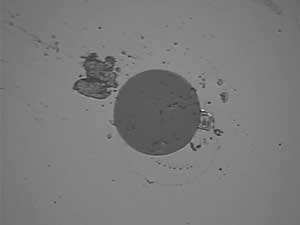
As
you can see, the dirt is large compared to the size of the fiber
(dark gray), and the core (not visible here) is only 9/125 of
the overall diameter of the fiber!
Clean
Every Connector - A Lesson We Learned From Creating Lessons
In creating
the fiber
characterization
curriculum, we got inputs from many experienced techs about the
testing requirements. Everyone we talked to made a big point
about cleaning and inspecting connectors before testing. Dirty
connectors are a major problem with errors in testing. We've
also seen that many installers think that if a connector,
especially new connectors, has a "dust cap" on the connector, it
does not need cleaning. WRONG!
The common name for the plastic caps on connector ferrules is
"dust cap" and a friend says they
are called "dust caps" because they are full of dust.
Those plastic caps are made by the millions, popped out of
plastic molding machines into barrels and stored until put into
plastic bags. Whenever you remove one of them, clean the
connector before testing or connecting it.
More on connector cleaning is here and here.
More
on cleaning. See Product
News below for links to vendors of fiber cleaning products.
What
You Need To Know About Fiber Optic Cleaning And More
Ed
Forrest, one of the industry experts on cleaning fiber optic
connectors, retired about a year ago. We encouraged him to put
down on paper what he knew about fiber cleaning and he took our
advice. He's now created 4 books on cleaning topics that cover
just about everything you need to know. And he added another
volume that's also important - maintaining fusion splicers. We
recommend these books highly.
How to Precision Clean All
Fiber Optic Connections
Understanding Cross-Contamination Points on Fiber Optic
Inspection & Test Equipment
Maintaining a Fiber Optic Fusion Splicer
Comparison Study of Precision Cleaning Methods for All Fiber
Optic Connection
Whitepaper: The Significance to Optical Internconnect:
Properly Cleaning a Fiber Optic Connection
Information on Ed's books is at http://fiberopticprecisioncleaning.com/available-books-whitepapers/.
See
news about Fiber Optic Cleaning Videos on YouTube by ITW
Chemtronics below.
Fiber Optic Cleaning Videos on YouTube
See news about Fiber Optic Cleaning Videos on YouTube by ITW
Chemtronics three fiber optic cleaning videos on YouTUbe
covering Dry
Cleaning, Wet-Dry
Method, FiberWash
and Combination
Cleaning. They are good explanations of cleaning processes
- the Wet-Dry is especially interesting.
- Westover
Application Notes And Cleaning Video
- Westover
has several application notes on inspecting and cleaning
fiber optic connectors. The video is a big file (50+MB) but
a good tutorial.
- Download
page: http://www.westoverfiber.com/Support/downloads.php
-
Measurement
Uncertainty: Everyone testing fiber optics should understand
that every measurement has some uncertainty - whether you are
measuring loss, length, wavelength, power, etc. Knowing that
uncertainty is very important to interpreting the measurement.
It's worthwhile to read and understand the issue of measurement
accuracy covered in this
page of the FOA Online Fiber Optic Reference Guide.
RETURN
TO INDEX
Worth
Reading or Watching:
Sign
up at the FOA Pinterest
board 
FOA
"Quickstart Guides"
In our
continuing quest to help people understand how to test fiber
optic cable plants and communications systems, we've created two
more "QuickStart Guides to Fiber Optic Testing." They are
simple, step-by-step guides on how to test fiber optic cable
plants, patchcords or single cables using insertion loss or OTDR
techniques and optical power from transceivers. It's as
straightforward as it can get - what equipment do you need, what
are the procedures for testing, options in implementing the
test, measurement errors and documenting the results.
It can't get much simpler.
Send anybody you know who needs to know about fiber optic
testing here to learn how it's done in a few minutes.
Testing
Fiber Optic Cable Plants And Patchcords
Testing
Fiber Optic Cable Plants With An OTDR
Measuring
Optical Power In Communications Systems
New
Edition Of Eric Pearson's Fiber Optic "Cookbook"
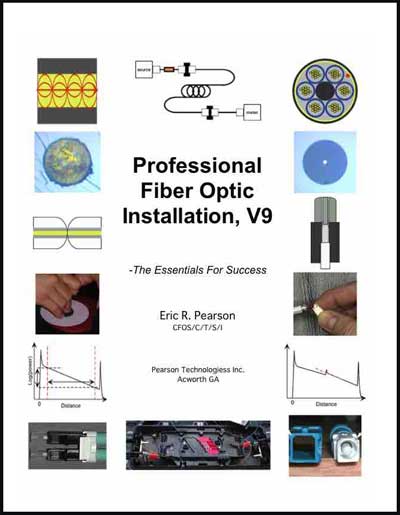
Eric
Pearson of Pearson Technologies Inc. announced the availability
of Professional Fiber Optic Installation, v.9. This
recently updated training, field, and reference text is a
comprehensive presentation of the information essential to
successful fiber optic installation.
This text assists the installer in achieving the three
elements of success: low power loss, high reliability, and low
installation cost. This text is the ideal tool for three types:
those who wish to become professional fiber optic installers;
for instructors who want to use the most comprehensive training
manual available; and for those who want to pass the Fiber Optic
Association CFOT and CFOS/C/S/T certification examinations.
Continuously developed and tested over the last 24 years during
both fieldwork and training presentations, this text includes
both the information essential to understand the reasons for the
installation rules and detailed procedures for installation,
inspection, certification, and testing of cables, connectors,
and splices.
The
new edition, #9, is available on Amazon.com.
Like
Crossword Puzzles? Here's Some On Fiber Optics
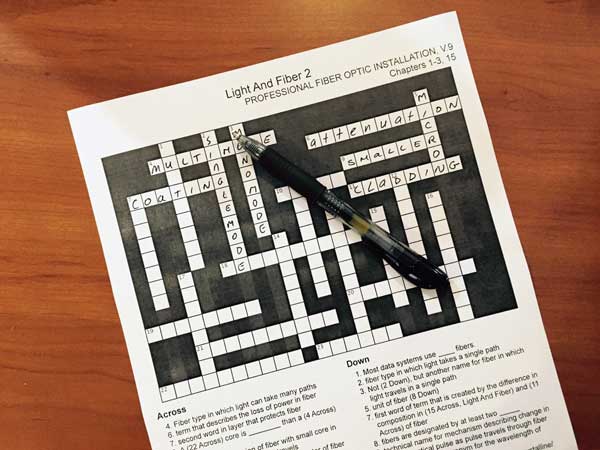
Do you like
crossword puzzles? How about one on fiber optics - or maybe a
half-dozen of them? FOA Master Instructor Eric Pearson of Pearson
Technologies has created a series of crossword puzzles on
fiber optics that are keyed to the FOA CFOT reference materials
and his book Professional
Fiber Optic Installation, v.9. You can have fun and
study fiber optics at the same time!
This months crossword puzzle is on "Optoelectronics and
Splicing" - Download
the crossword puzzle on "Optoelectronics
and Splicing."
If you
missed the earlier puzzles, here they are:
Download
the PDF file of the crossword on "Light and Fiber".
Download
the PDF file of the crossword puzzle on "Cables".
Download
the crossword on "Connectors
& Splices."
Older
Fiber, Do You Know How Good It Is?
There's
millions of miles of long distance fiber installed around the
world and most of it likely to see an upgrade of the systems
operating on it, probably in the near future. Twenty years ago,
most of it was probably running at ~1Gb/s, ten years ago it was
probably 2.5 Gb/s, recently it was likely to be 10Gb/s but now
many are being considered for 100Gb/s or beyond. Can the fiber
support such speeds? Can it be "repaired" or "modified" to make
it possible to use it at higher speeds? If you own that fiber,
can you say what it is worth without knowing its future upgrade
capability.
In order to know the potential for upgrades on your cable plant,
you need to test it. This process involves a number of tests and
is called "fiber characterization." Greg Stearns of TTP-US, an
FOA Corporate Member, performs these tests and has written a
short article on why you need to characterize fiber and how its
done. Read about fiber characterization from someone who does it
often and can explain it well.
Download
the paper here (PDF, 80kB).
Demystifying
Singlemode Fiber Types
Singlemode
fiber has a lot of names and users are confused by the different
names depending on the standards organization you refer to IEC,
ITU or TIA designation. Most widely used are the ITU G65X
designations but even there we find many designations. Shaun
Trezise of M2FX has posted a simple explanation on the company
blog that helps explain the different types and where they are
used. Read
more on the M2FX blog
There is a cross
reference to the IEC, ITU and TIA designations on the FOA
Guide.
NEXANS
FTTO Guide
NEXANS UK
has published a FAQ guide explaining the benefits of a "Fibre To
The Office" (FTTO) solution as an alternative to traditional
structured cabling installations.
Download
the guide here.

Want to
keep up with gigabit FTTH, try reading or subscribe to the GigCommunities
Newsletter.
EXFO
Offers Super Posters And More

EXFO offers some super posters, guides and books. The FTTx and
OTDR posters are really useful! Look
at the whole selection here.
Getting Cables Out Of Conduit
Usually we are concerned about reducing friction when pulling
cables through conduit, but sometimes you need to get them out.
Here
is a page from American Polywater the leading lubricant
company with advice on the subject.
What Is The FOA?
Hear FOA President Jim Hayes tell the FOA Story in a 2-part
interview by Sound & Video Contractor Contributing Editor
Bennett Liles. It tells about the FOA history, goals and
achievements.
Part 1: http://svconline.com/podcasts/audio/fiber_optic_association_part1/index.html.
Part 2 http://svconline.com/podcasts/audio/inside-fiber-optic-association2-0924/index.html.
New
Textbook On Cleaning Fiber Optic Connectors
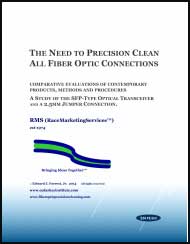
As fiber optic networks become faster and link margins lower,
cleaning fiber optic connectors has become more critical. Now
there is a book that gives really good information on cleaning
from a real expert.
Ed Forrest retired from ITW Chemtronics recently after many
years of being their expert on cleaning fiber optic connectors.
Ed has been one of our best contacts on the subject because his
knowledge is both broad and deep. When he retired, we suggested
he write a book on fiber optic cleaning and he took our advice.
Ed's book is like a cookbook, looking at specific cleaning
recipes, plus evaluating the tools commonly used for cleaning.
It's also in color which makes it easier to see what is being
done, although it makes the book a bit more expensive.
Now you can buy The Need to
Precision Clean Fiber All Optic Connections, A study of
the 'sciences of cleaning', contemporary cleaning products,
methods and procedures by Edward J Forrest Jr. The book is
available online from CreateSpace, the same publisher FOA uses.
Go here for more information on the book: https://www.createspace.com/5120367
What
Happens To Old Fibers?
In a recent web search, we found this article from Corning,
reprinted from a IWCS presentation in 1995. It discusses
extensive tests on a 1984 cable installed in the northern US to
see how it had degraded in almost 10 years. It is interesting to
see how the fiber survived OSP exposure. Read
it here.
Australia's
Standard Is Comprehensive Guide To Customer Cabling (Get your
copy free)
In
answering a recent technical questino, Trevor Conquest in
Australia pointed to the Australian Standard "Installation
Requirements For Customer Cabling." When we checked, it is on
the web and can be downloaded. It's a big book - 220 pages -
full of details for fiber and copper installations. We recommend
you download
yourself a copy - go here.
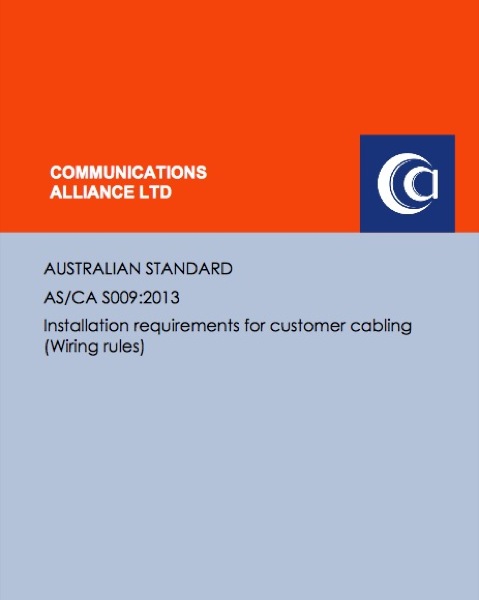
Demystify
fiber inspection probe technical specifications -
From EXFO
The
intent of this application note is to promote a better
understanding of video inspection probe specifications and
features. Properly understanding the key specifications
and features will greatly facilitate the decision process
involved in acquiring such devices. Understanding the key
aspects of fiber inspection probes will also help users
understand how fiber inspection probes operate, thus
enabling them to maximize the full potential of these
devices. Read
more.
Where
In The US Do Contractors Need Licenses For Fiber Optics?
We often
get asked where in the US do contractors doing fiber optic
installations need licenses. We found a good website for that
information, the NECA -NEIS website. You might remember
NECA-EIS, as they are the partner with the FOA in the NECA/FOA
301 Fiber Optic Installation Standard. NECA is the National
Electrical Contractors Association and NEIS stands for National
Electrical Installation Standards. They have a very easy to use
map and table that gives you data on every state in the US, so
mark these pages for future reference.
NECA/NEIS
http://www.neca-neis.org
(See “State Regulations”)
http://www.neca-neis.org/state/index.cfm?fa=state_regs
(all electrical licensing)
Low Voltage: http://www.neca-neis.org/state/index.cfm?fa=specialty_licensing
How Is
Fiber Manufactured?
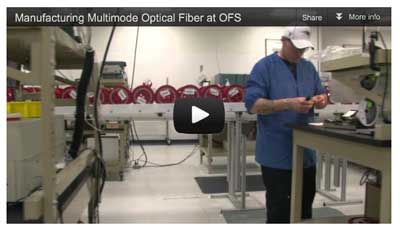
OFS invites you on a tour of their multimode fiber manufacturing
facilities in this new 5-minute video. You will see their highly
automated manufacturing operation in Sturbridge, Mass.,
including their patented MCVD preform fabrication process to
fiber draw and final product testing. With a technological
heritage dating back to AT&T and Bell Labs, OFS has been
manufacturing high-quality multimode fiber since 1981.
Watch
the video here.
Adding
Cables By Recovering Conduit Space
Maxcell has
been a pioneer in the field of fabric innerduct to expand
capacity of typical fiber ducts by replacing rigid plastic
innerduct with flat fiber innerduct. (See
FOA Newsletter July 2014) Now they have a method of
removing current innerducts without disturbing the live cables
in them and adding fabric innerducts to double or triple the
capacity of the conduit. They have special gear to pull out the
current ducts leaving the cable in place and split the duct to
remove it from the cable and prepare it for chipping for
recycling.
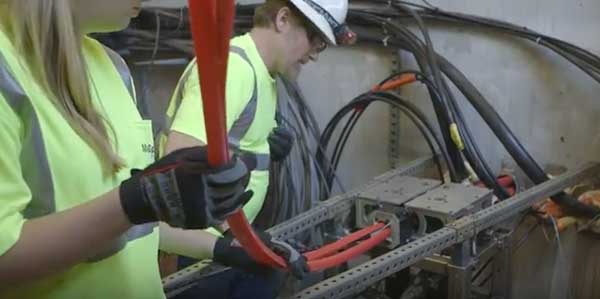
All the plastic ducts in the conduit are removed (above) and
multiple fabric innerducts are pulled in by the last innerduct
as it is removed (below). (From Maxcell video)
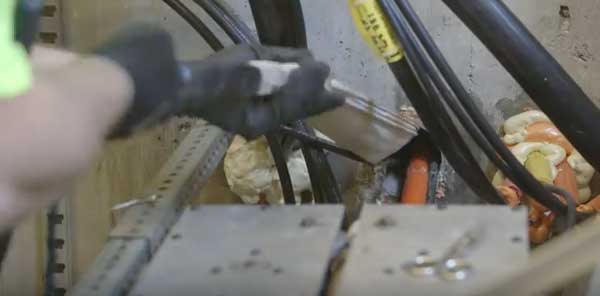
After all the old rigid innerduct is removed, you can pull
additional cables into the fabric ducts immediately.
The advantages are obvious - getting space for additional
cables without installing more conduit - no more construction,
no additional cost beyond the simple - and quick - process of
removing the old innerduct and pulling in the new.
Watch
the Maxcell video on YouTube here.
Interesting
Video On Directional Drilling For Fiber Optic Cable
Installation
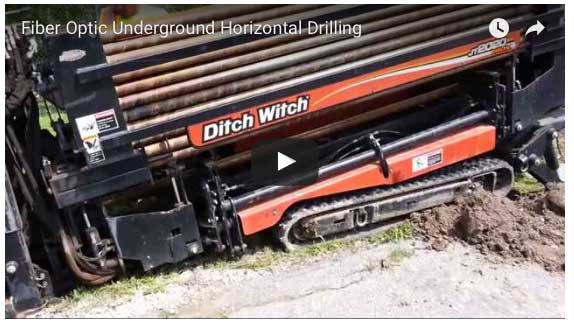
CI&M magazine has posted an interesting video about how Time
Warner Cable installs underground fiber optic cable by
directional boring. It's a good look at how directional boring
works. Watch
it here on CI&M's website.
CI&M Editor also does a good review of alternative cable
installation methods in an article on the magazine website. Read
it here.
Want To
Know Where Submarine Fiber Optic Cables Run?
There
is a good map online by TeleGeography you can access here.
Benchmarking Fusion Splicing
And Selecting Singlemode Fiber
We've been asked many times "How long does it take to splice a
cable?" It's not a simple answer as it varies with the number of
fibers in the cable and the work setup, including whether one or
two techs are working at a job site. FOA Master Instructor Joe
Botha of Triple Play in South Africa did his own analysis based
on decades of experience both splicing cables and teaching
others how to do it properly. This is one of the best analyses
we have seen because Joe includes prep times as well as splicing
times and differentiates between one tech and two techs working
together. He adds some other tips on fusion splicing too. This
should be mandatory reading for every tech and given to every
student! Here
is Joe's splicing analysis.
Joe also has an excellent writeup on how
to choose singlemode fiber that helps understanding
the different types of G.6xx fiber. Read
it here.
And you will want to read Joe's report on splicing
different types of SM fiber, including bend-insensitive
(G.657) fiber. Read
it here.
Free
- Mike Holt's Explanation Of The US National Electrical Code
(NEC) For Communications Cables
Mike Holt
is the acknowledged expert of the US National Electrical Code
(NEC). His books and seminars are highly praised for their
ability to make a very complicated standard (that is in fact
Code - law - in most areas of the US) easily understood. Part of
the appeal is Mike's great drawings that make understanding so
much easier. Mike makes Chapter 8 of his book available free. It
covers communications cables, telephones, LANs, CATV and CCTV,
for premises applications. Even if you live in a region or
country where the NEC is not the law, you may find this
interesting.
Download
Mike's Chapter Here.
Fiber
Optic Cleaning Videos on YouTube
ITW
Chemtronics has three fiber optic cleaning videos on  covering Dry
Cleaning, Wet-Dry
Method, FiberWash
and Combination
Cleaning. They are good explanations of cleaning processes
- the Wet-Dry is especially interesting.
covering Dry
Cleaning, Wet-Dry
Method, FiberWash
and Combination
Cleaning. They are good explanations of cleaning processes
- the Wet-Dry is especially interesting.
A
Documentary Treasure on the History of the Internet
15
minutes of a rarely-seen BBC documentary demolish the myth that
ARPAnet was inspired by nuclear war, and explain the far more
intriguing truth.
http://www.technologyreview.com/blog/mimssbits/26719/?nlid=4433
-
- Download
yourself a copy and read it!
-
Good
Technical Website For Installers
American
Polywater (http://www.polywater.com/)
has one of the best technical website for cable installers. Check
out their website, especially “Videos,” “Engineer’s Corner”
and “Calculators.” http://www.polywater.com/NNNBSL.pdf
Fiber
Optic Safety Poster
We've had numerous requests to reprint our guidelines
on safety when working with fiber optics, so we have
created a "Safety Poster" for you to print and post in your
classroom, worksite, etc. We suggest giving a copy to every
student and installer.
RETURN
TO INDEX

" Heard on the Street" is a monthly online newsletter from Frank
Bisbee of Communications Planning Corporation that covers
the telecommunications and cabling businesses. Each month
includes news from manufacturers, trade associations and
professional societies like the FOA. You can read the current
issue and back issues online.
IGI, a major market research and technology reporting company
(the "Active Optical Cables" below) is offering a a free
one year subscription to one of our fiber optics newsletters to
FOA members. All they have to do is to send IGI an e-mail
stating which newsletter they would like to get. See http://www.igigroup.com/nl.html
for a listing of IGI Newsletters.
RETURN
TO INDEX
-
FOA
Tech Topics -
A
Fiber Optic Tester In Your Pocket? (See the video on
 )
)
Yes!
The camera in your old cell phone is sensitive to infrared light
- lots more than your eye - and can detect light in an optical
fiber or from a transmitter. Chris Hillyer,CFOT/CFOS/I,
Master Instructor, Northern California Sound & Communication
JATC brought this to our attention.
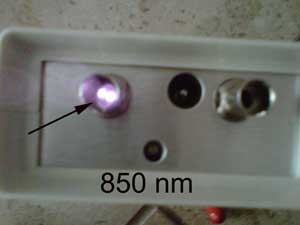
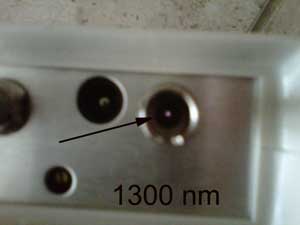
If
you have an old cell phone, try it. Our experience is that older
cell phone cameras have better sensitivity at IR wavelengths
than newer phones, so you may want to toss that old flip phone
into the toolbox.
RETURN
TO INDEX
Product
News
3M
FTTH Drop Cable
A new 3M
drop cable for FTTH has a 90 micron buffered fiber inside to
allow more rugged terminations directly on the fiber. It's
part of the "ClearTrack
System" for easier FTTH installs.
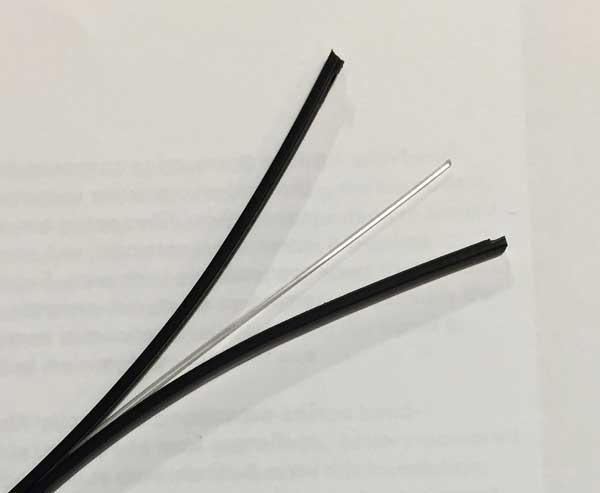
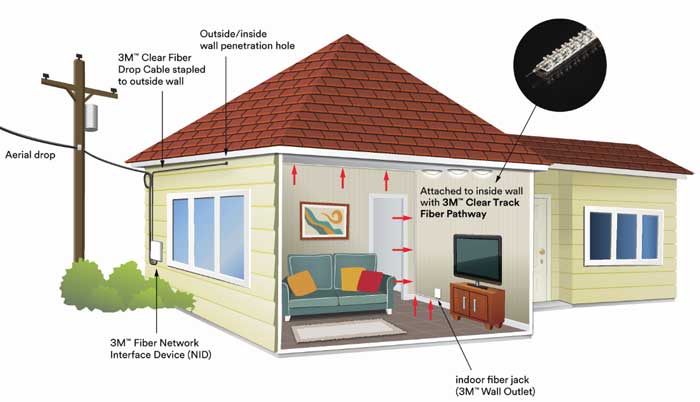
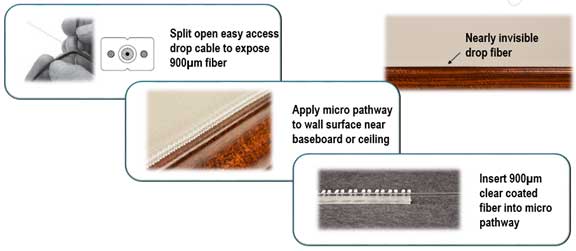
YOKOGAWA
OTDR Has Extended range, High Resolution And Multitasking
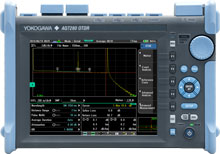
One OTDR manufacturer you don't hear as much about is YOKOGAWA
(formerly ANDO) which is too bad - they make some of the best
OTDRs, exemplified by this new model AQ7280. Need long range -
how about 50dB. High resolution - 0.6m dead zone. Like touch
screens, but for some functions want hard buttons, it's got
that. Options for VFL, microscope, light source and power meter,
etc. - it has that too.
But the unique aspect of the YOKOGAWA AQ7280 is it offers
multitasking - you can let do a trace with long averages while
you inspect connectors, make power readings, use the VFL or
other functions.
More
info on the YOKOGAWA AQ7280.
FOA
thanks Yokogawa for a gift of an OTDR to use for R&D and
teaching!
Recycling Communications Cable
FOA was
contacted by a company that recycles electronics communications
equipment and cabling. CommuniCom recycles
cable/metals/e-waste
for Telcos and CATVs. They also recycle Fiber Optic Cable and
associated Materials (the fiber scrap). And, they reclaim OSP
abandoned copper cables (abandoned from road moves or FTTx
growth). This is a huge part of our business. They do the work
(permitting/locates/labor) for free and we revenue share back
with our clients (telcos).
Contact
Steve Maginnis
smaginnis@communicominc.com
www.communicominc.com
803.371.5436 (cell)

Micro-Trenching, Cable
Removal
Nano-Trench
offers products for micro (or I guess they call it nano-)
trenching and their
website is very informative. They also have Kabel-X,
a method of extracting copper cables from old conduit. Both
websites are informative and interesting. Watch
this video on the cable removal process!
Protecting Pedestals From
Rodents
Pedestals
and underground vaults can be damaged by rodents who come up
through the base and damage cables. Uraseal "Drain N'Seal"
foam deters mice from taking up residence in your pedestals. They
have some good videos on using their product.
Used
Test Equipment – Buy or Sell
http://www.testequipmentconnection.com/
Have
you read the FOA
pages on cleaning?
- RETURN
TO INDEX
FTTH
Notes:
- Want
To Learn More About FTTx? Try our free online self-study
program at Fiber
U.
|




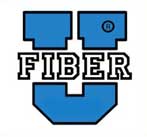










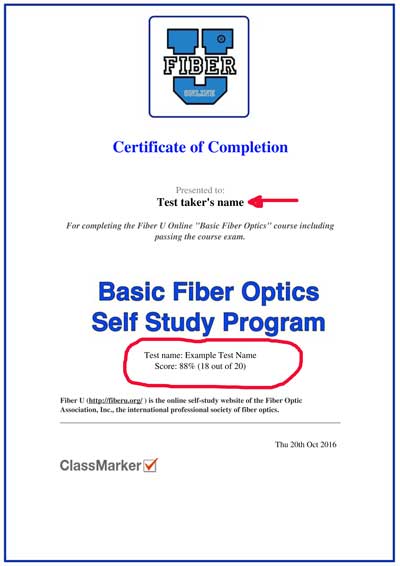
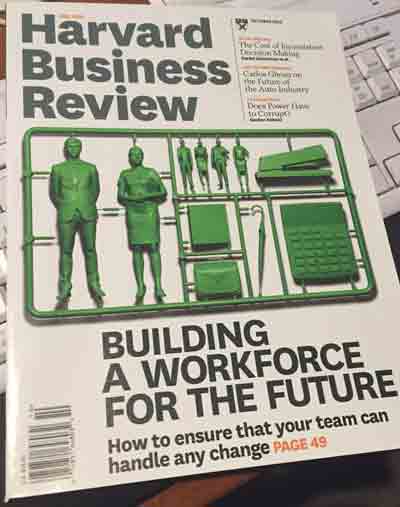
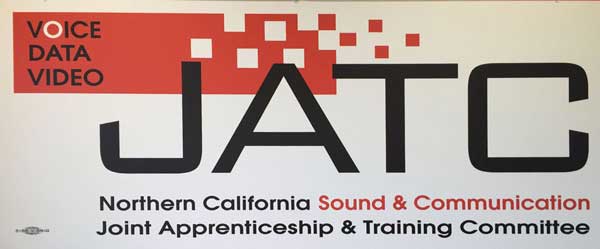
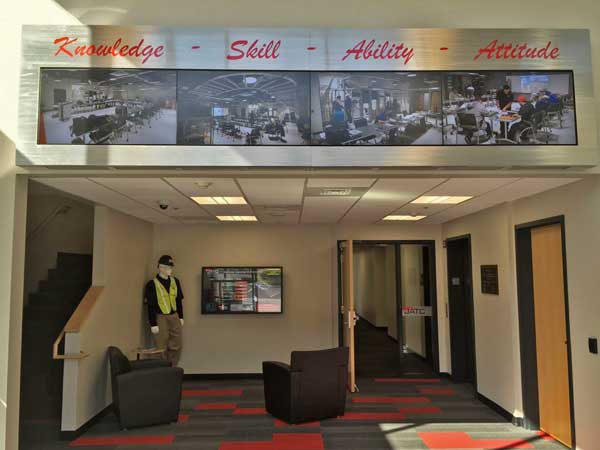
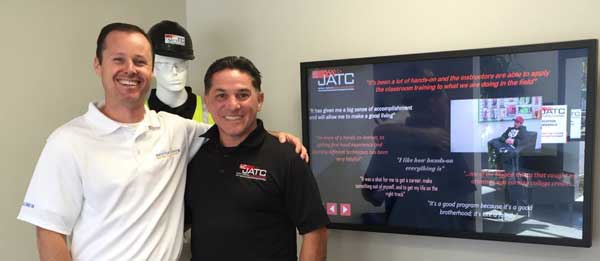
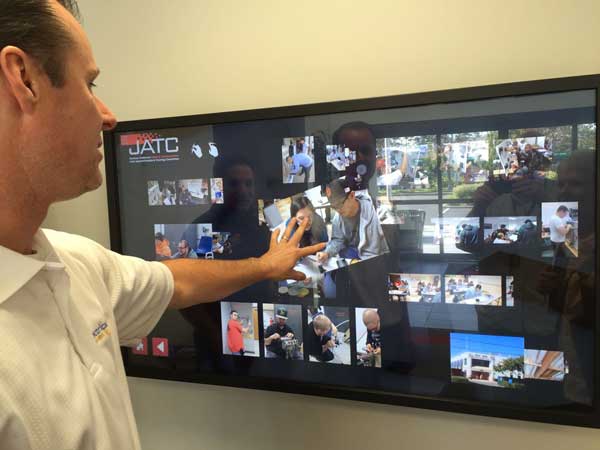








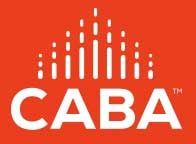









































 .
.


























